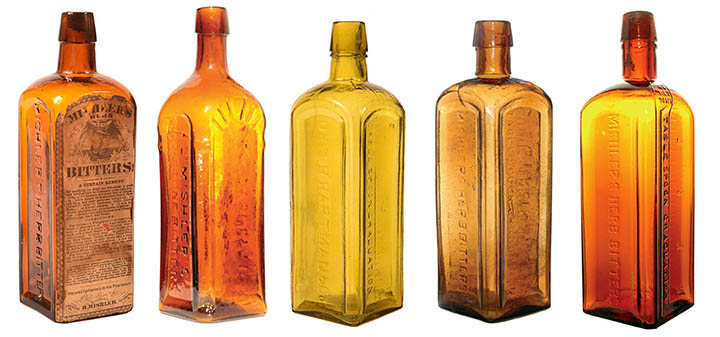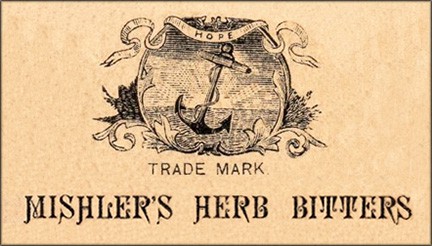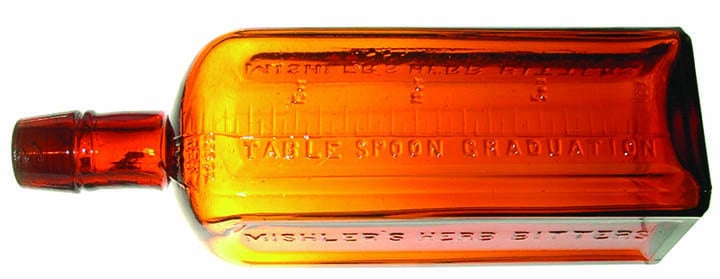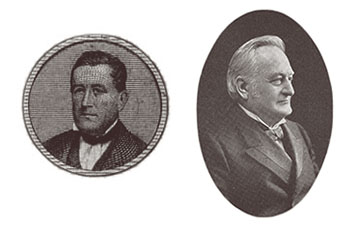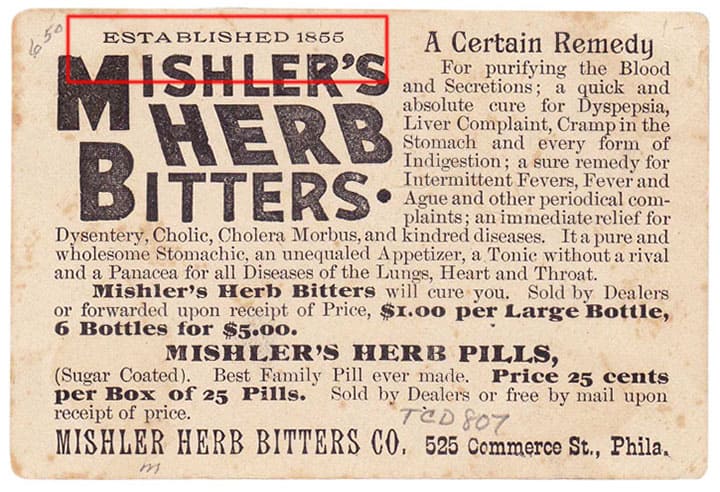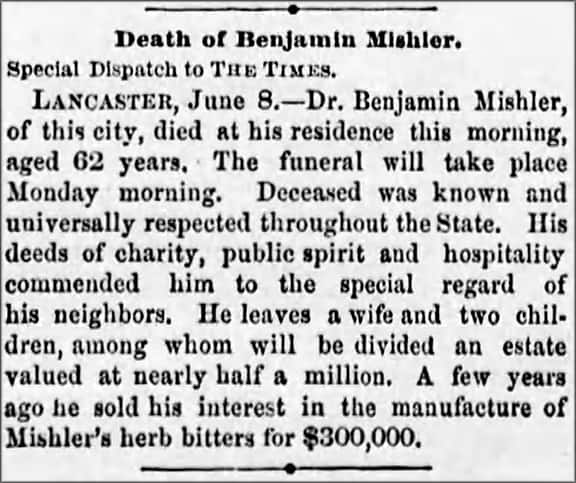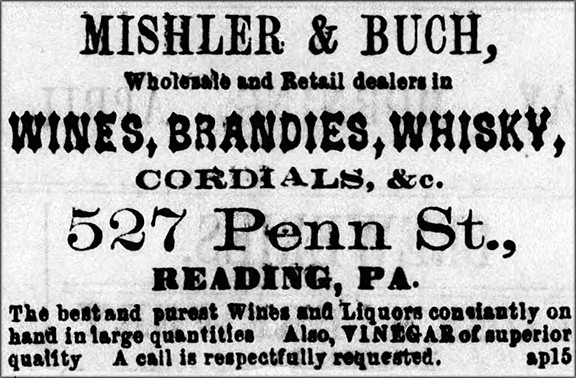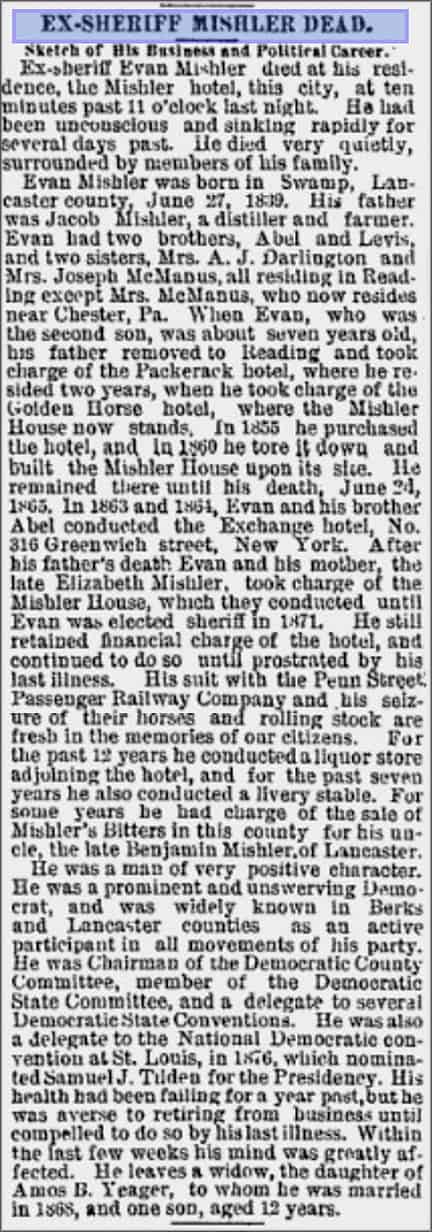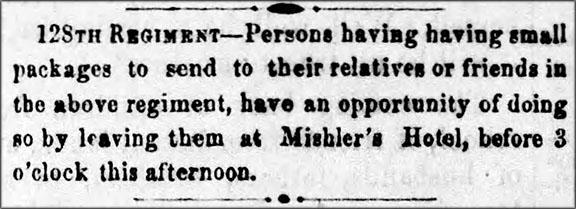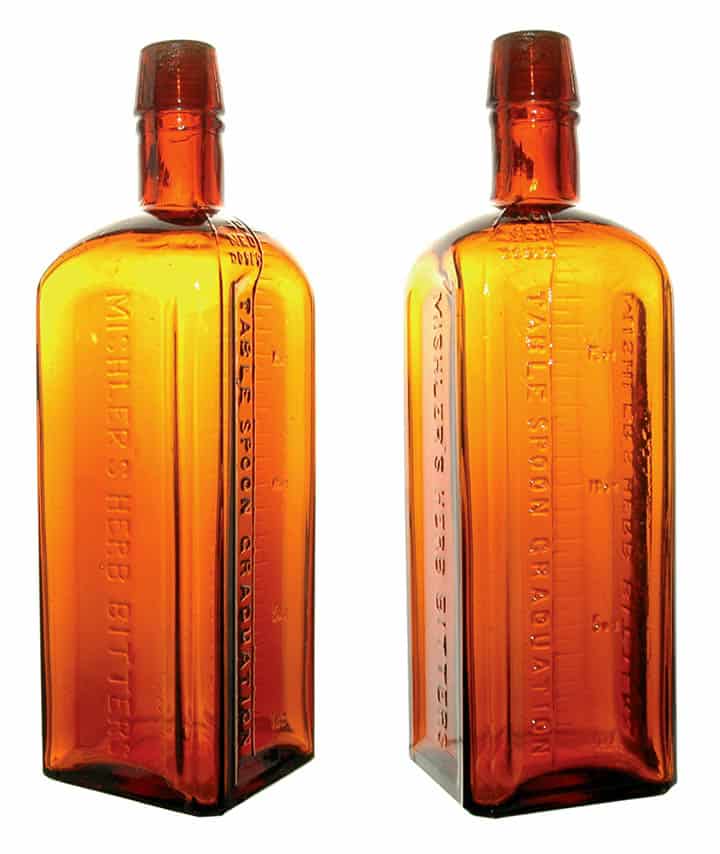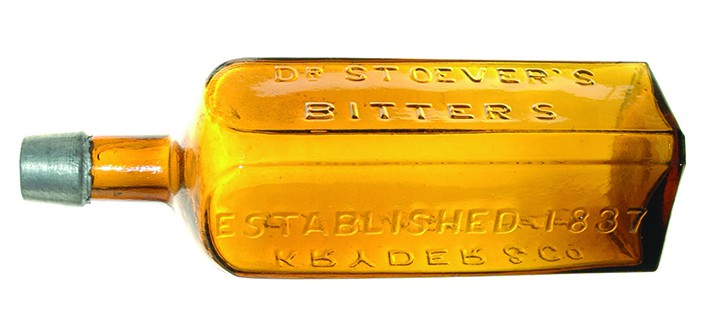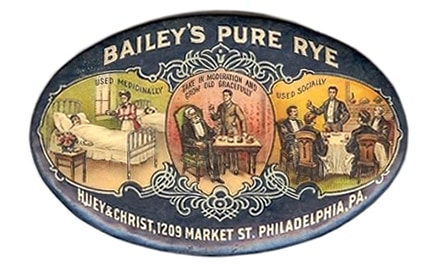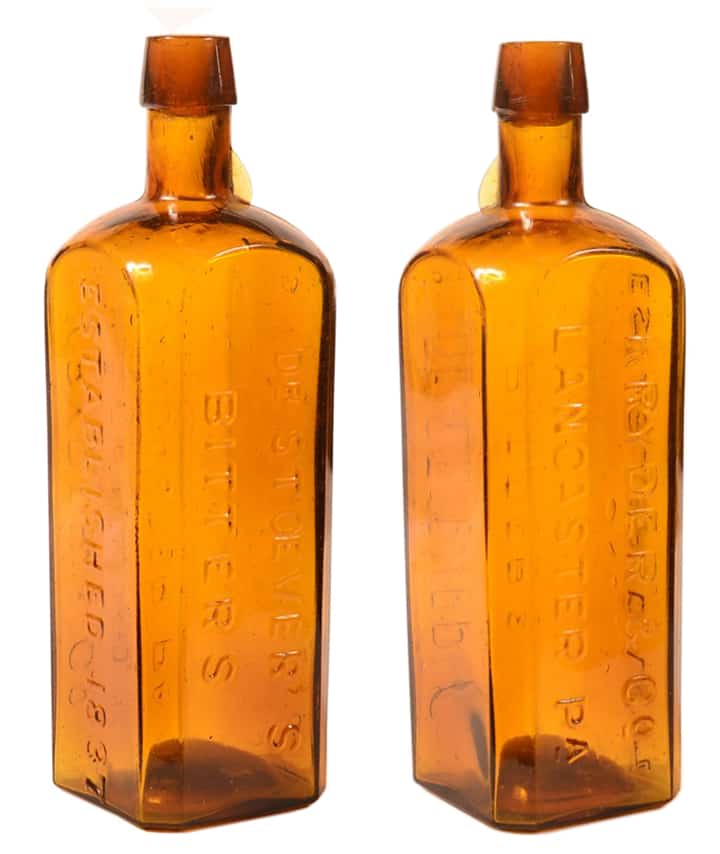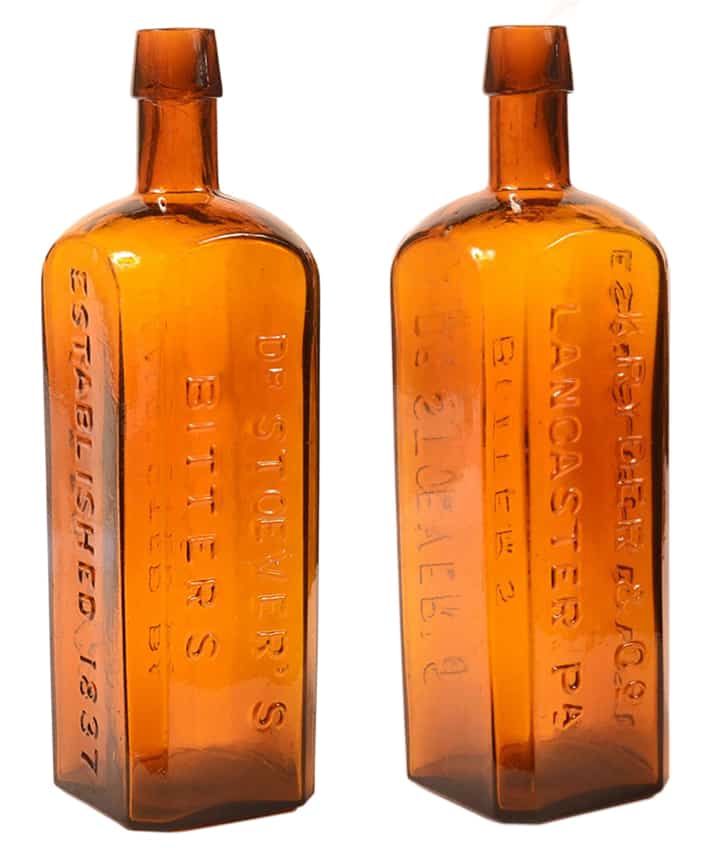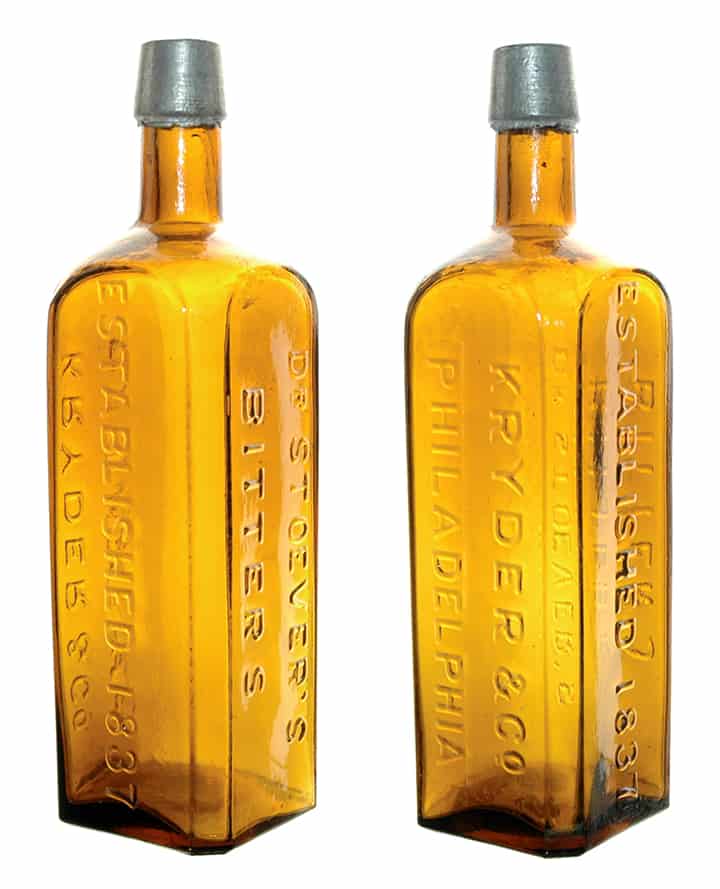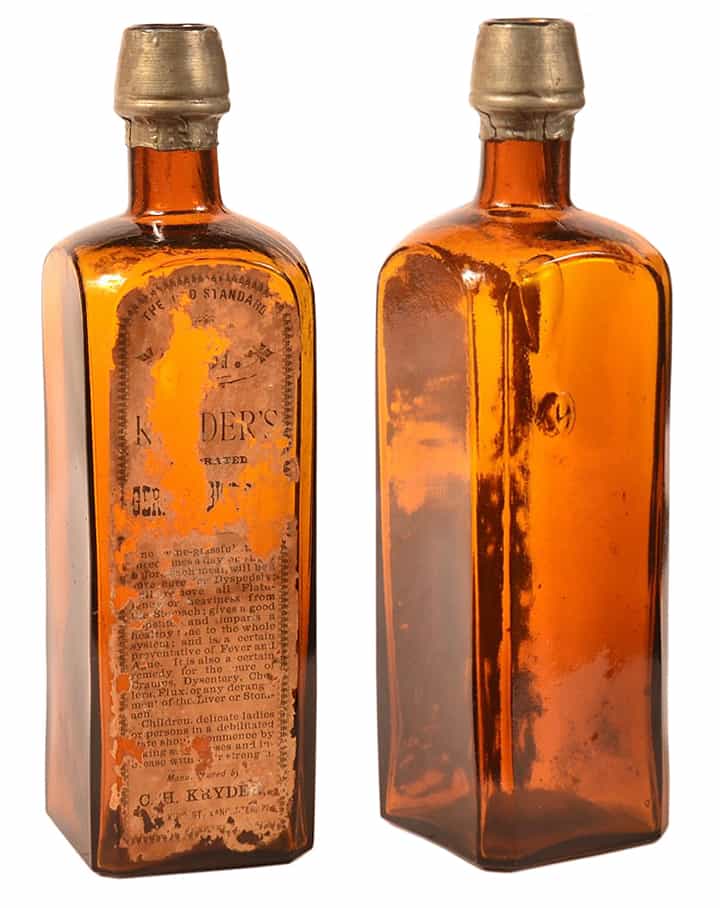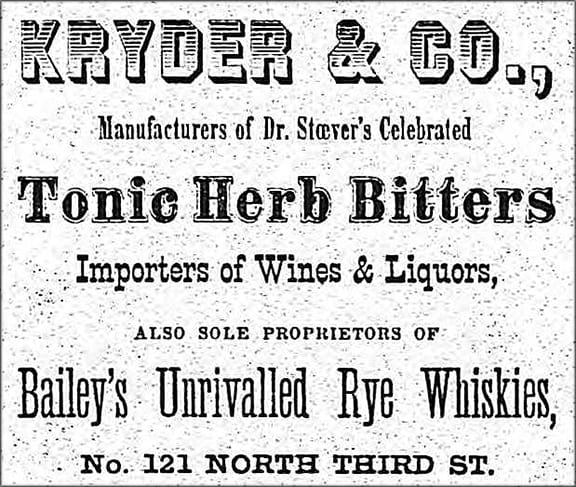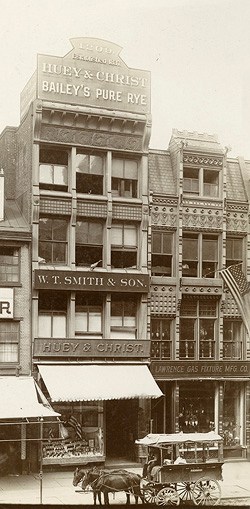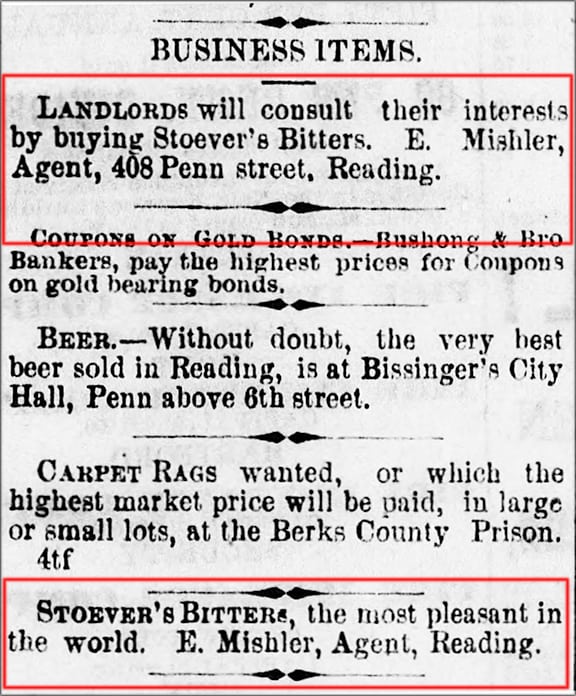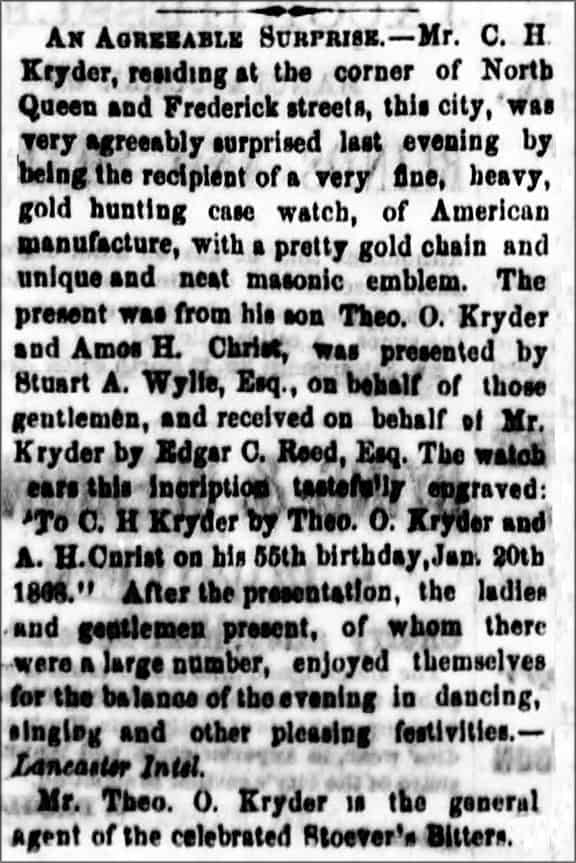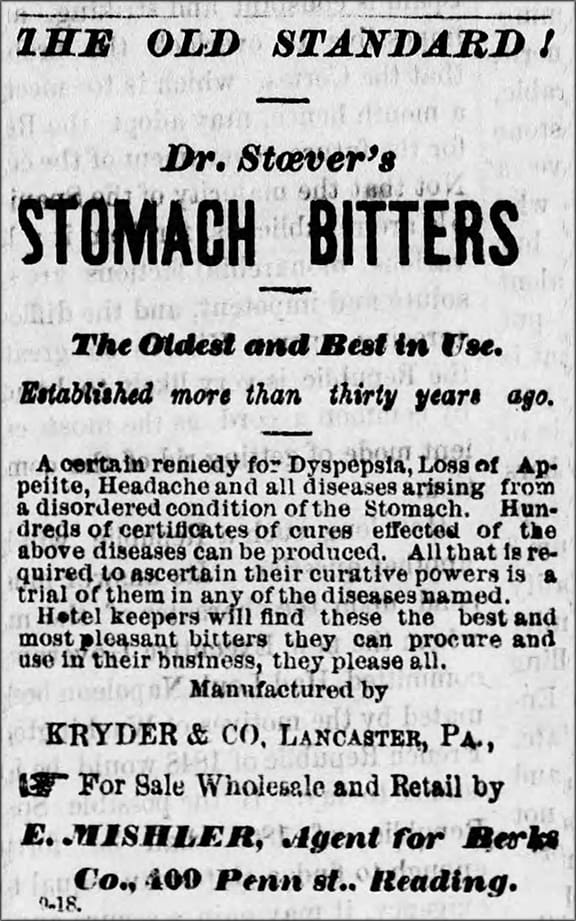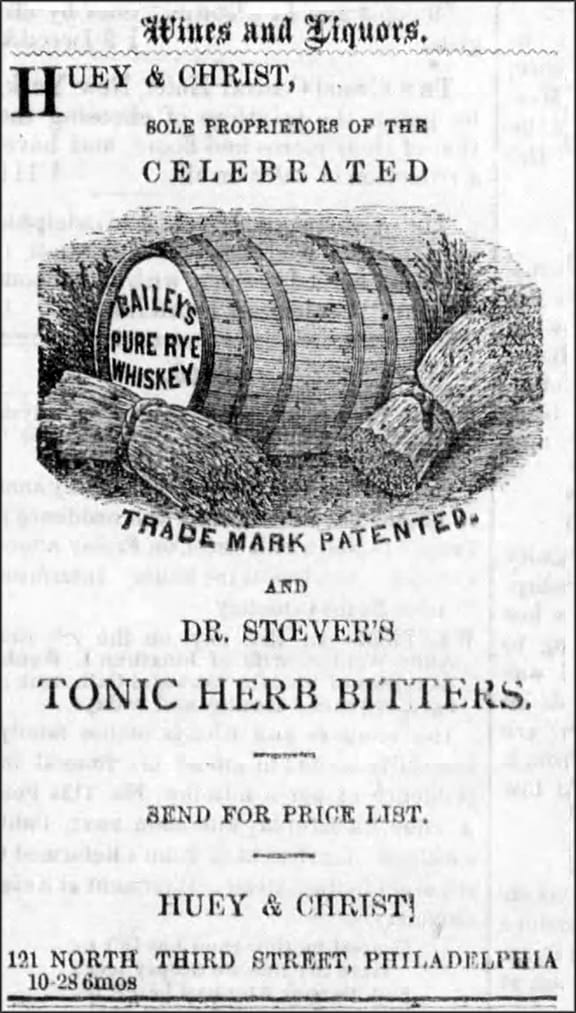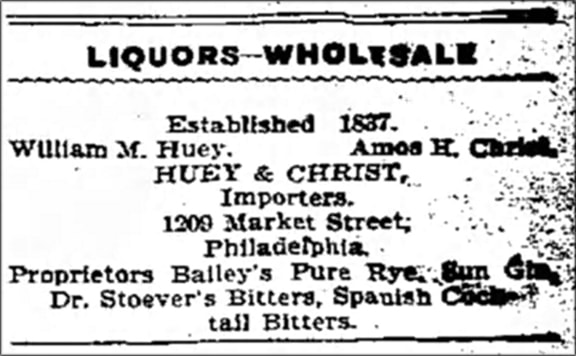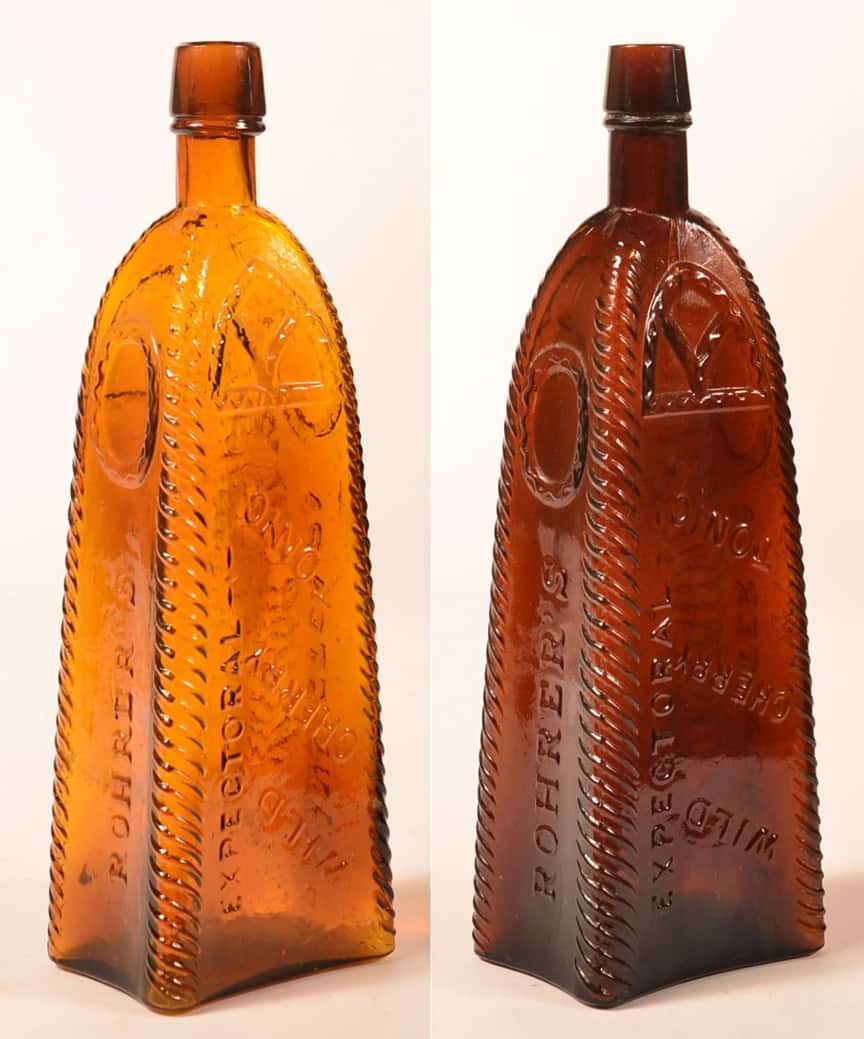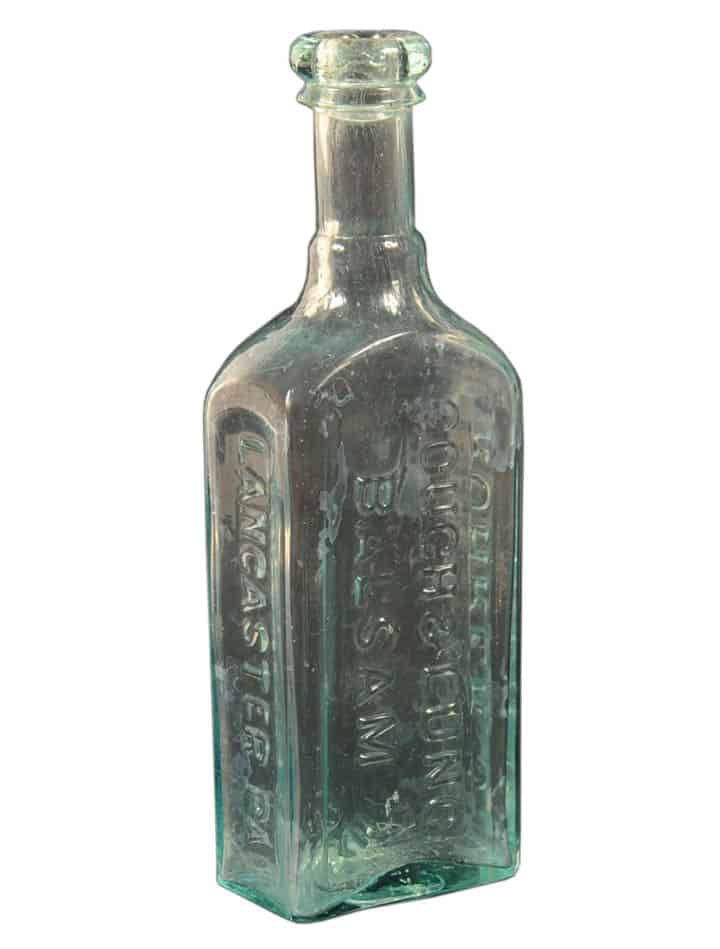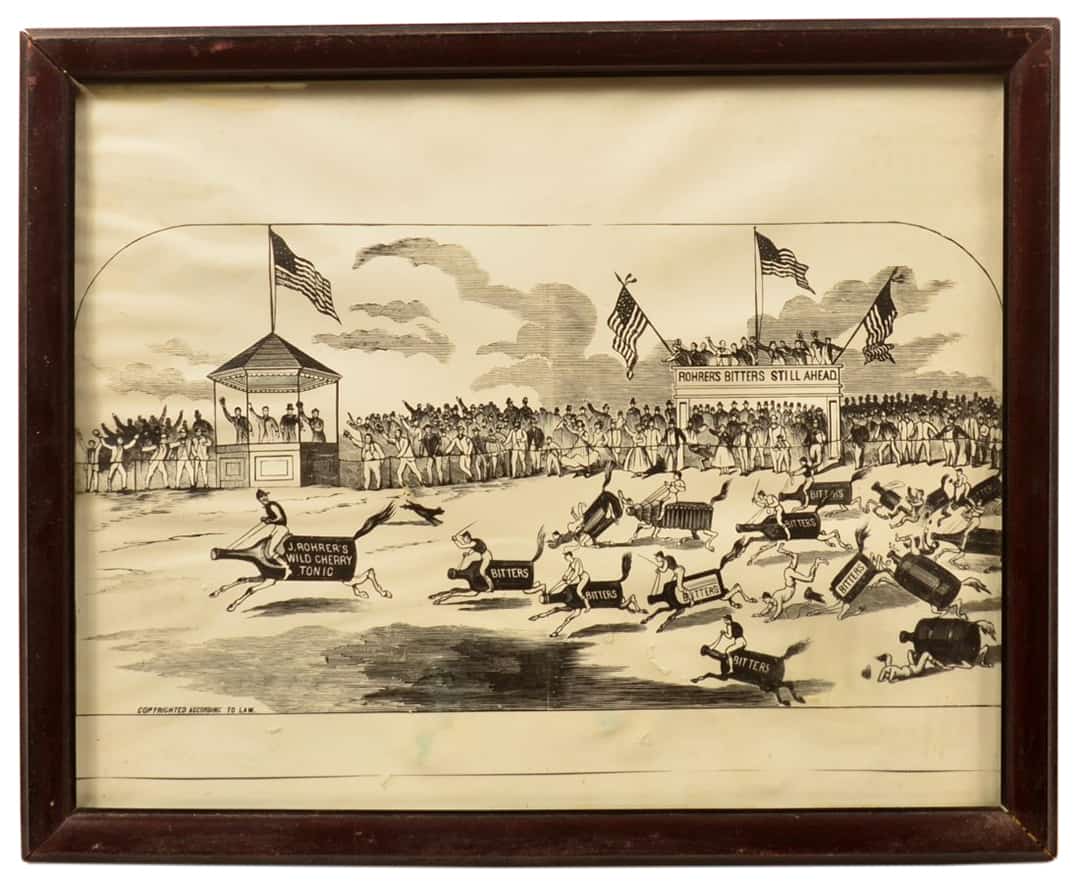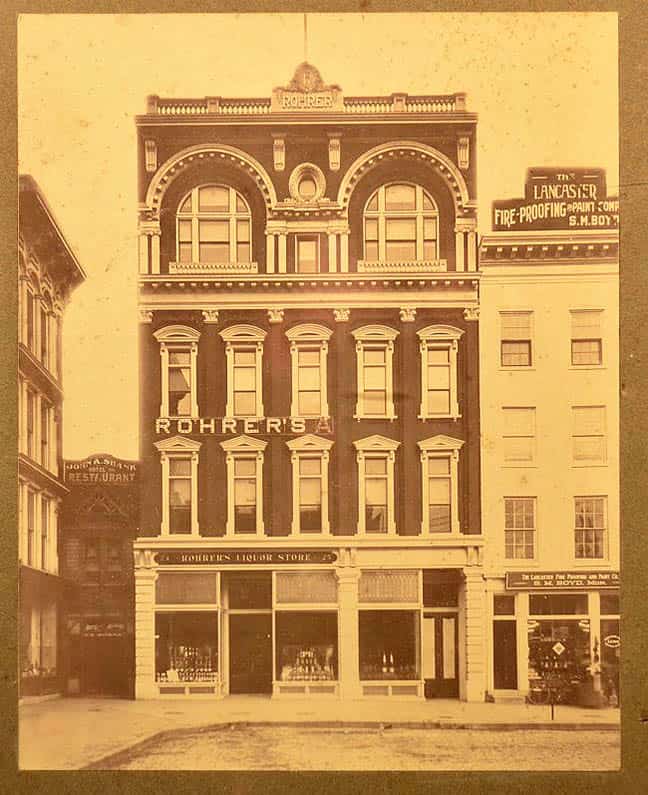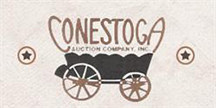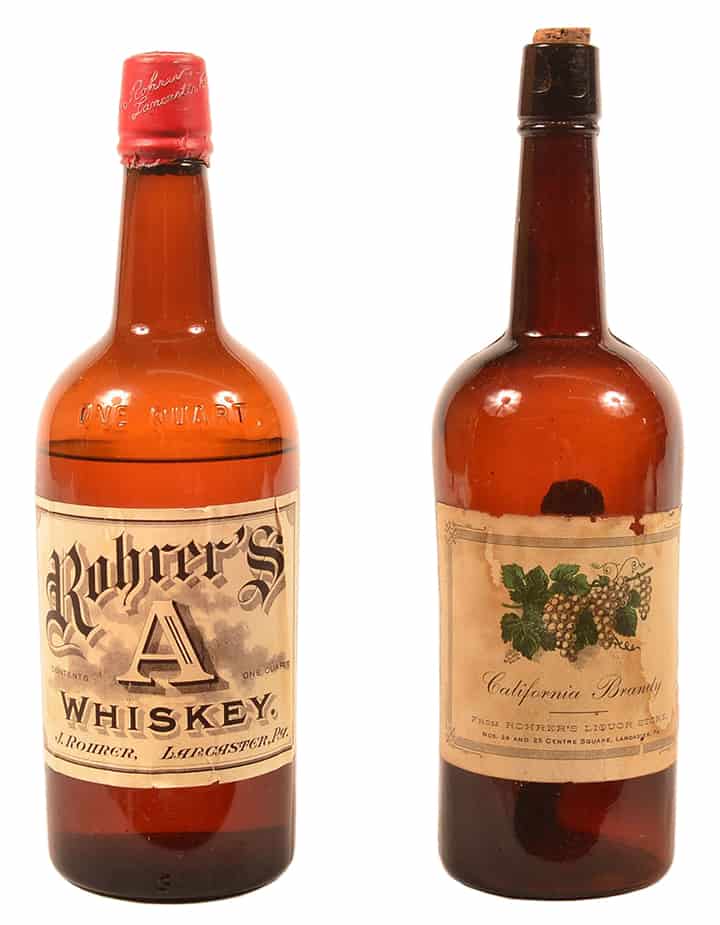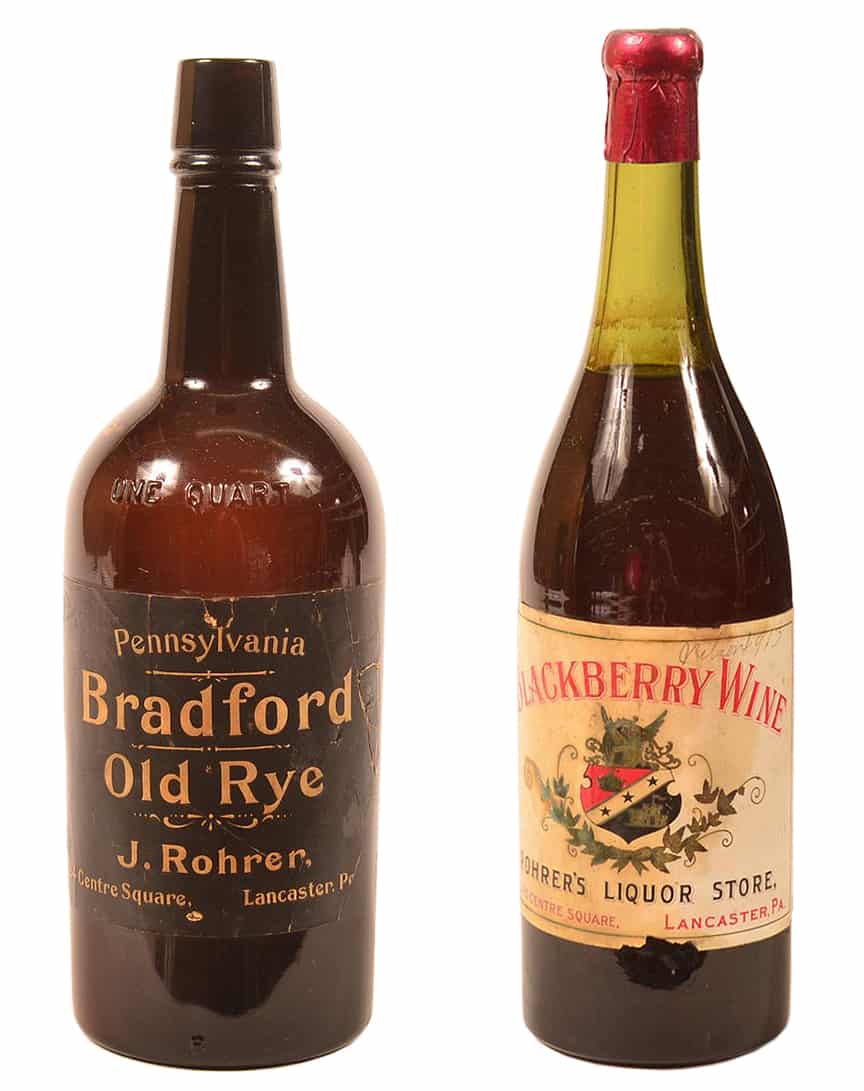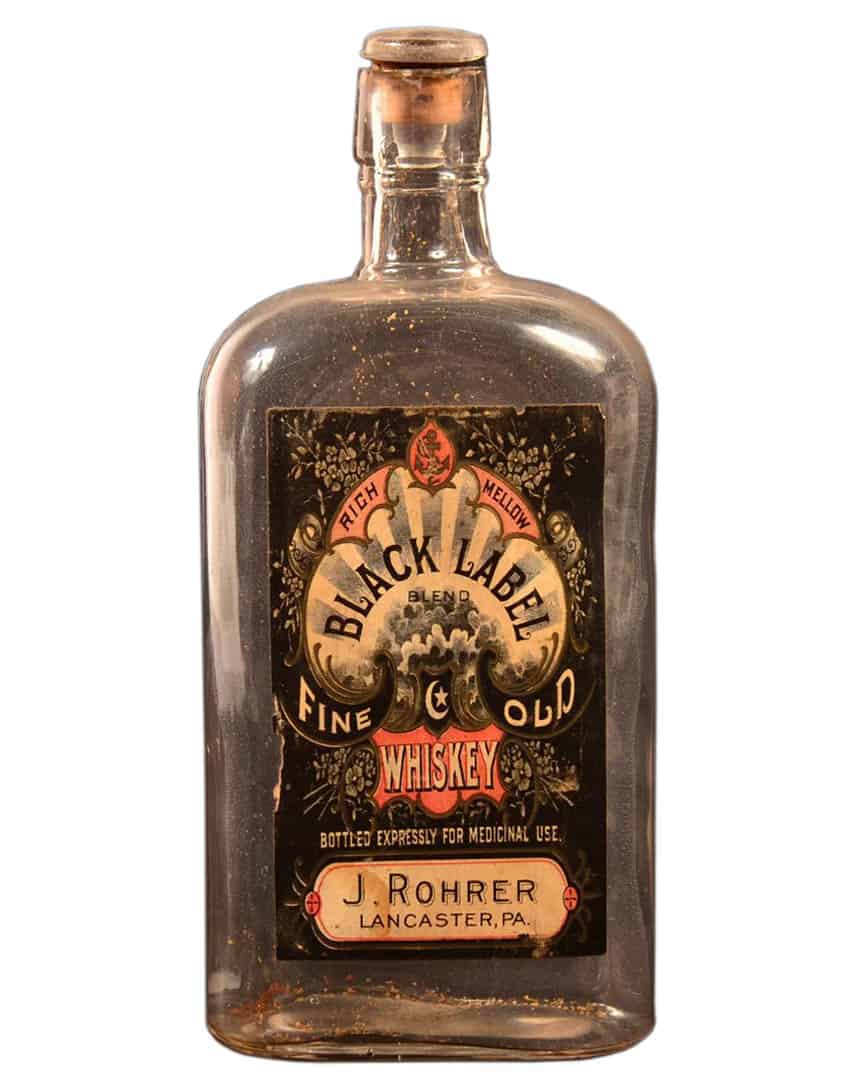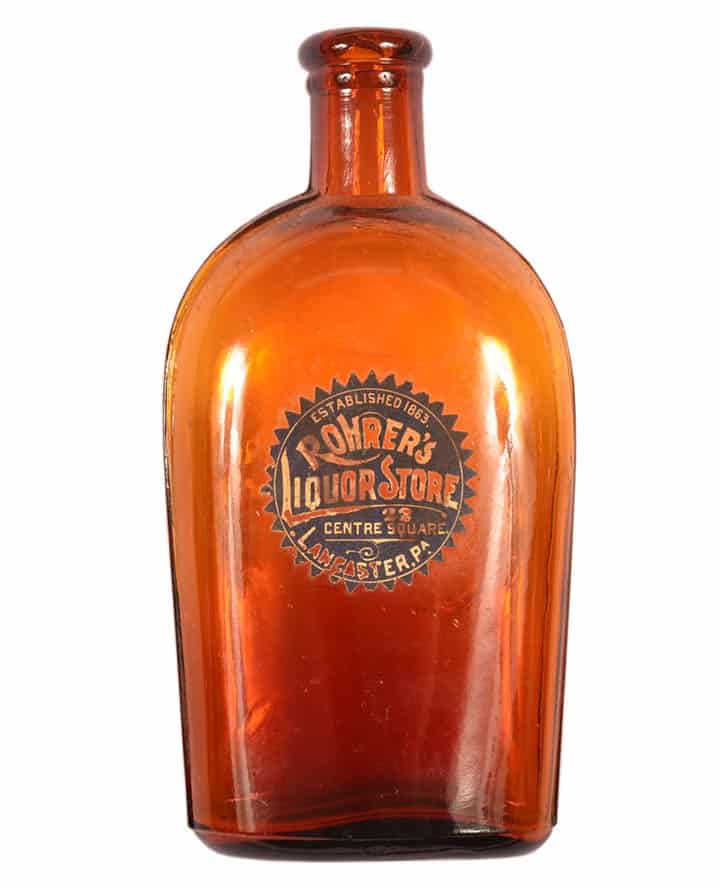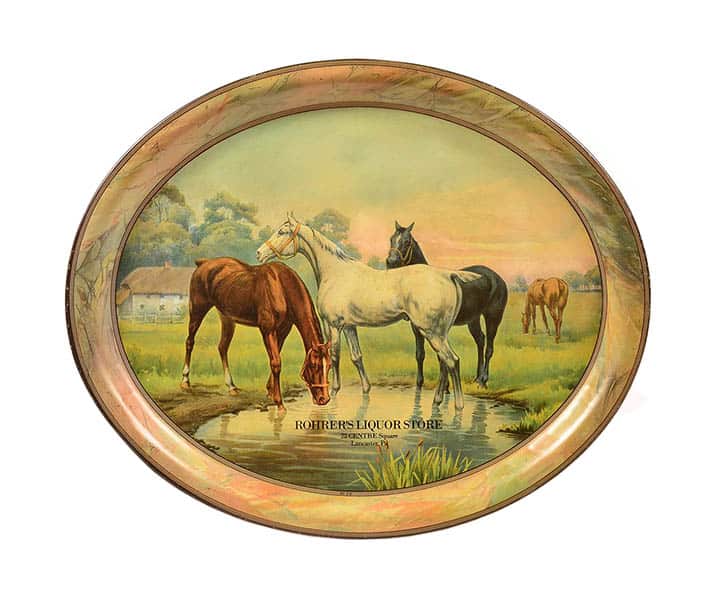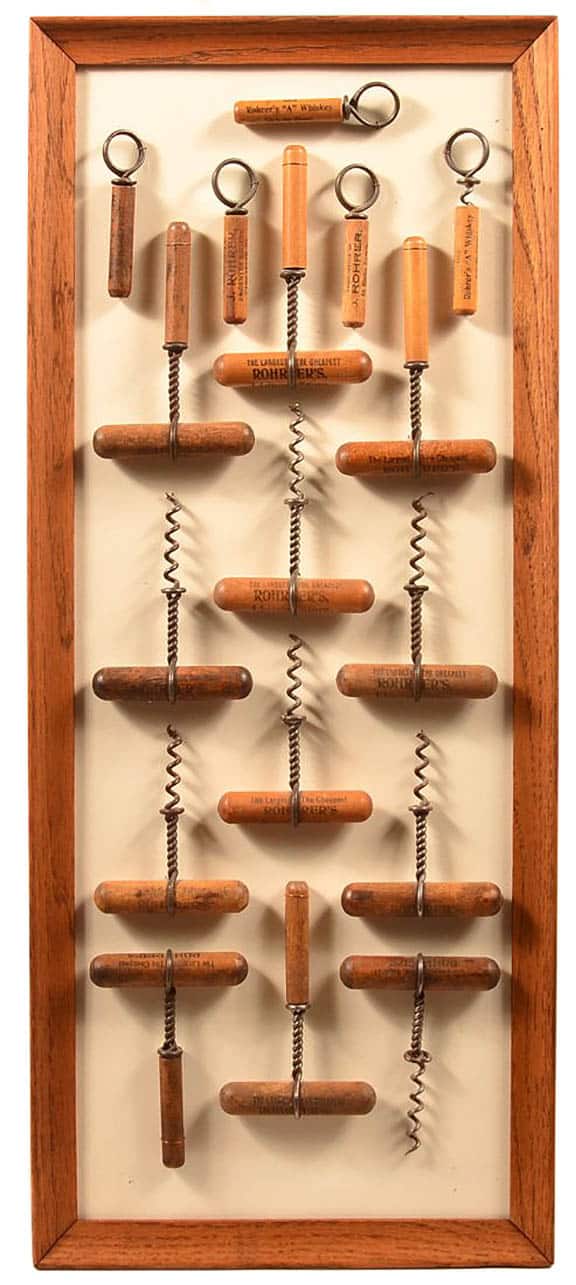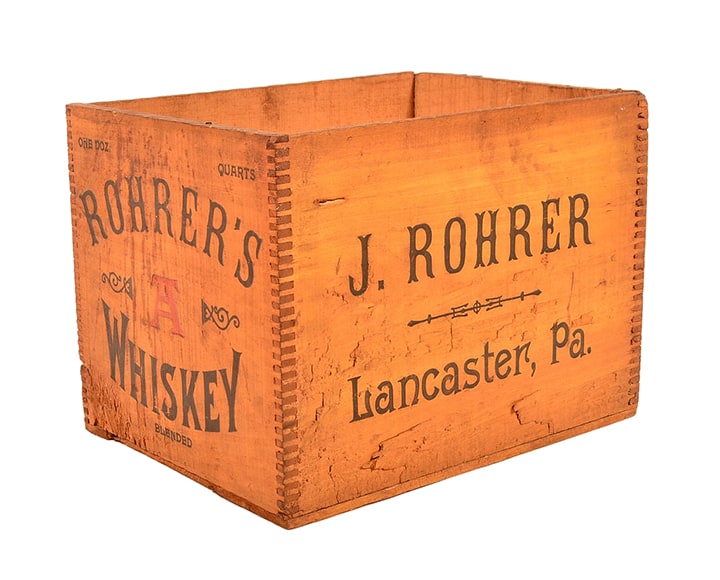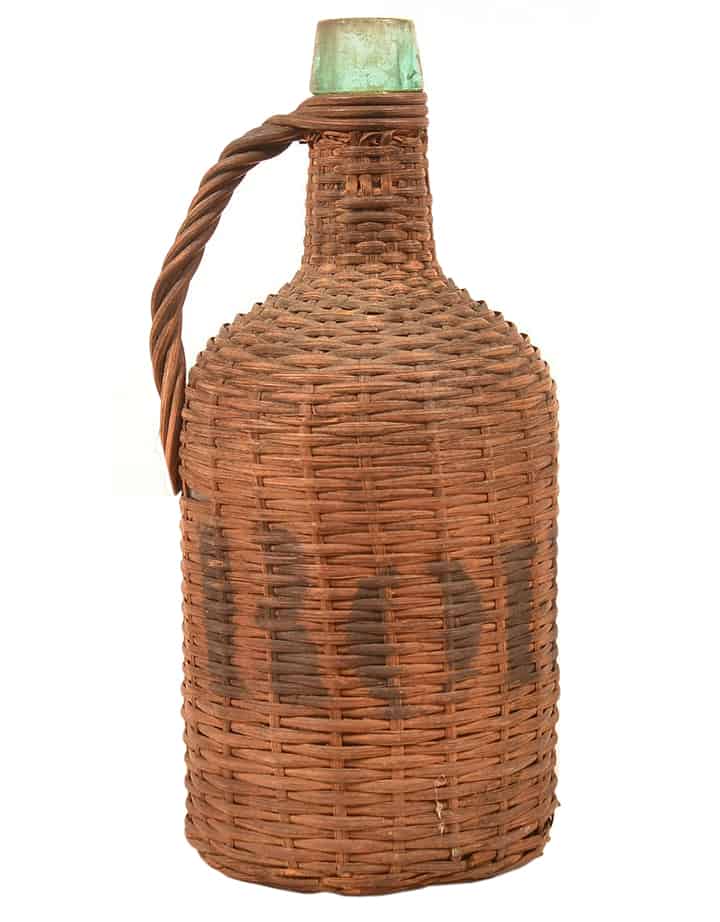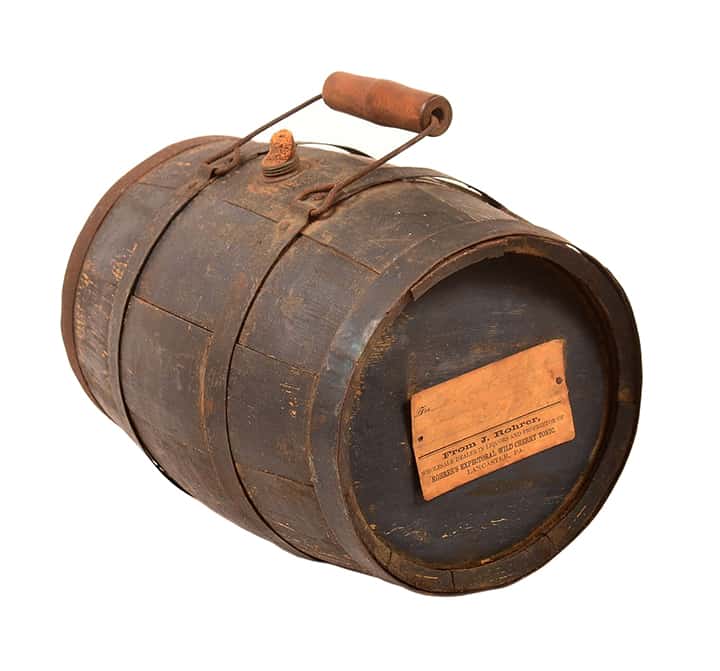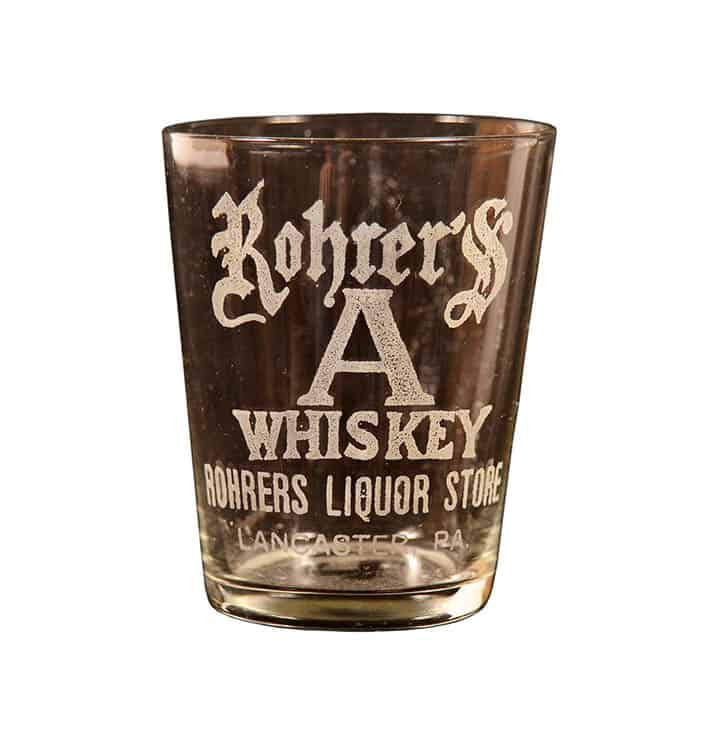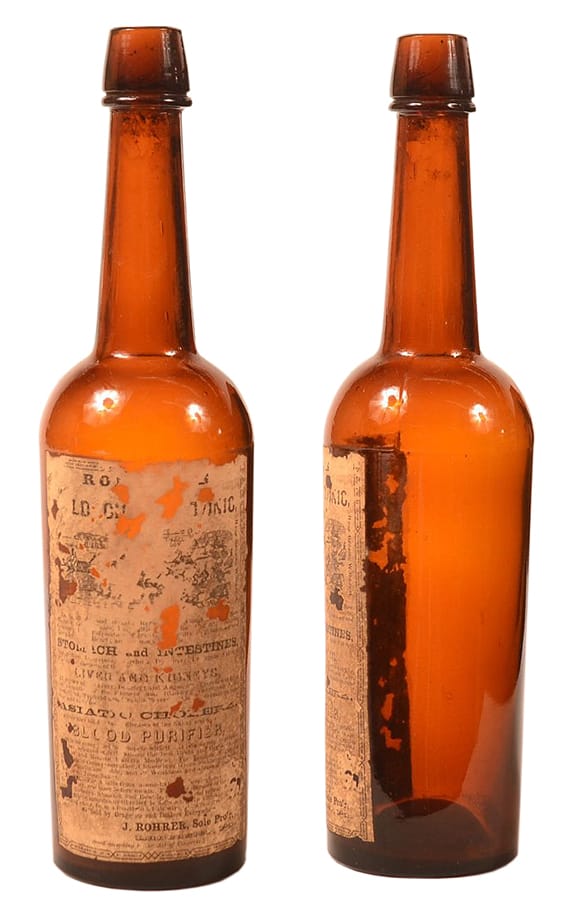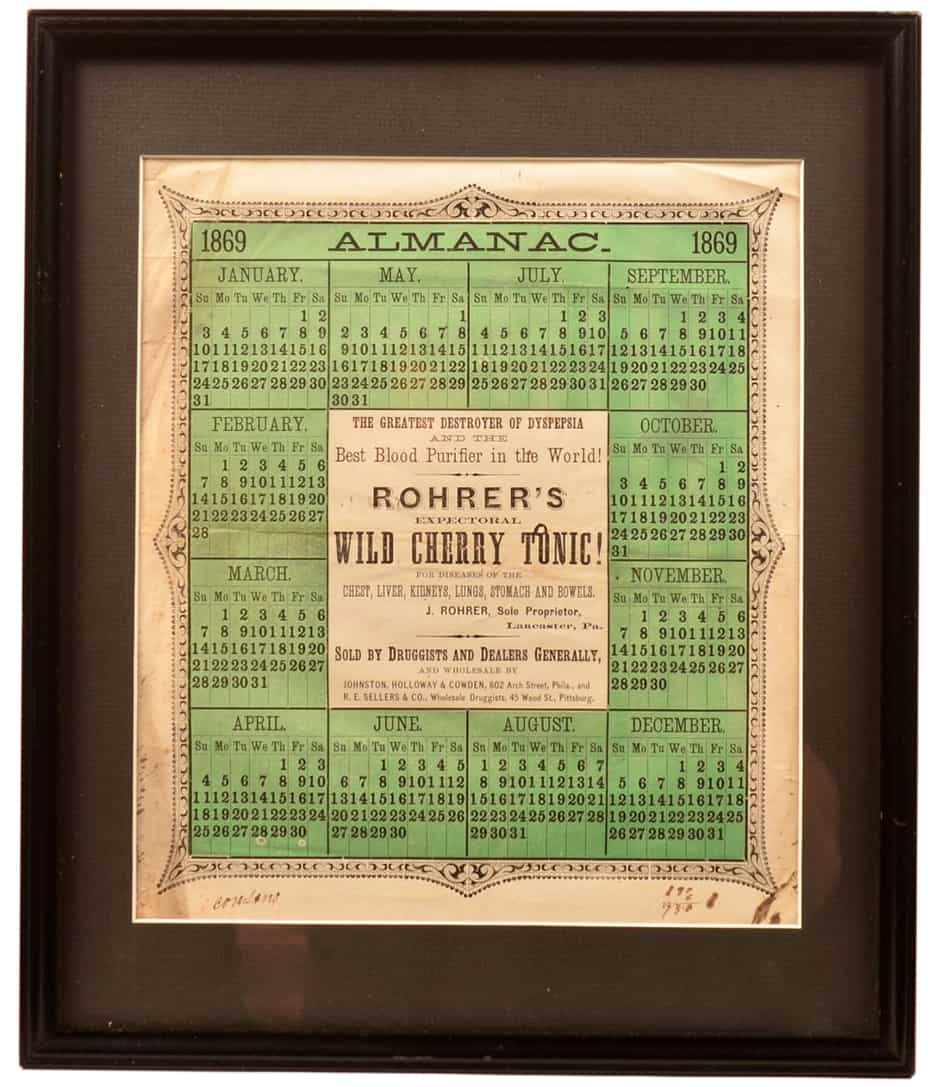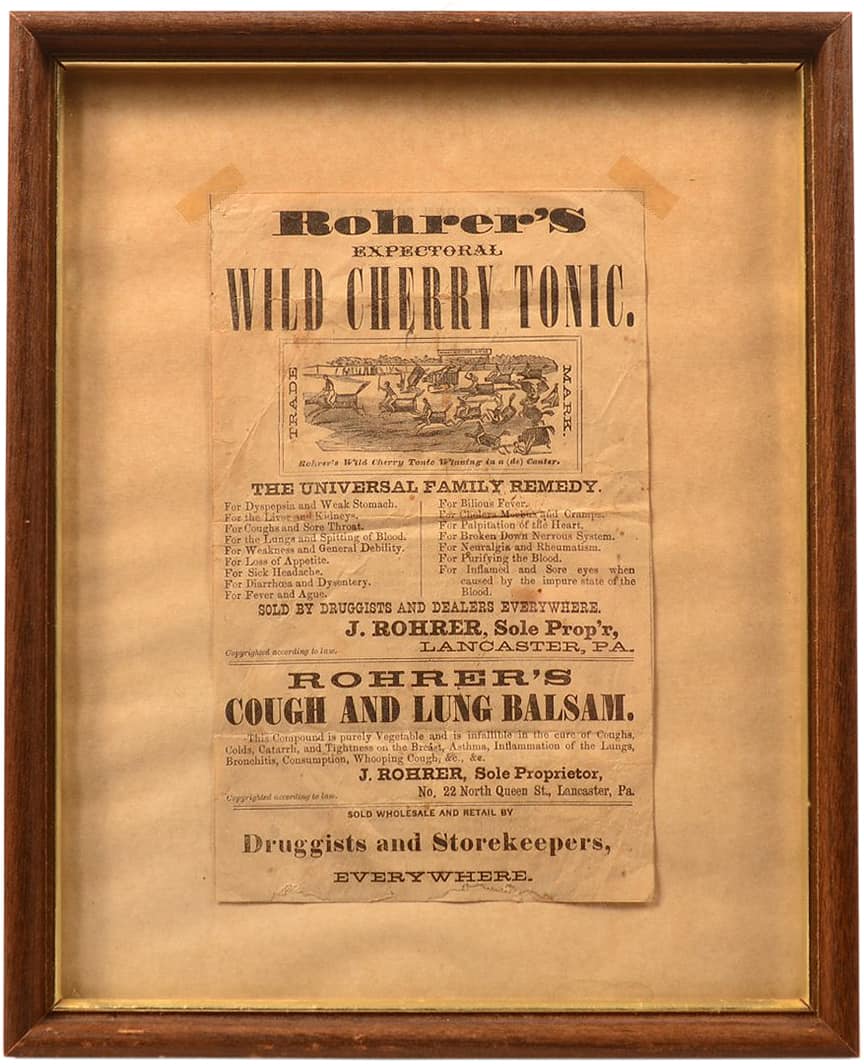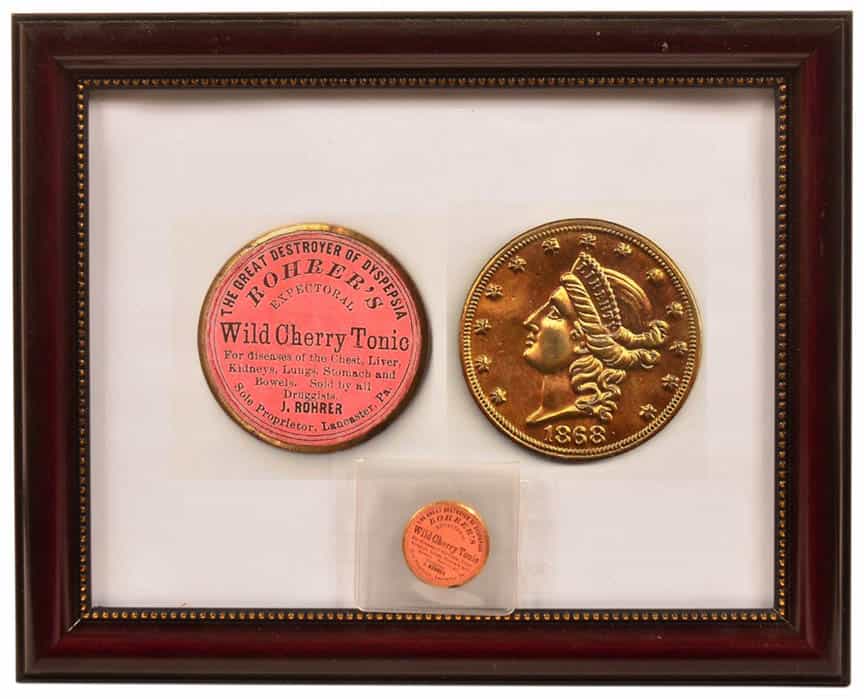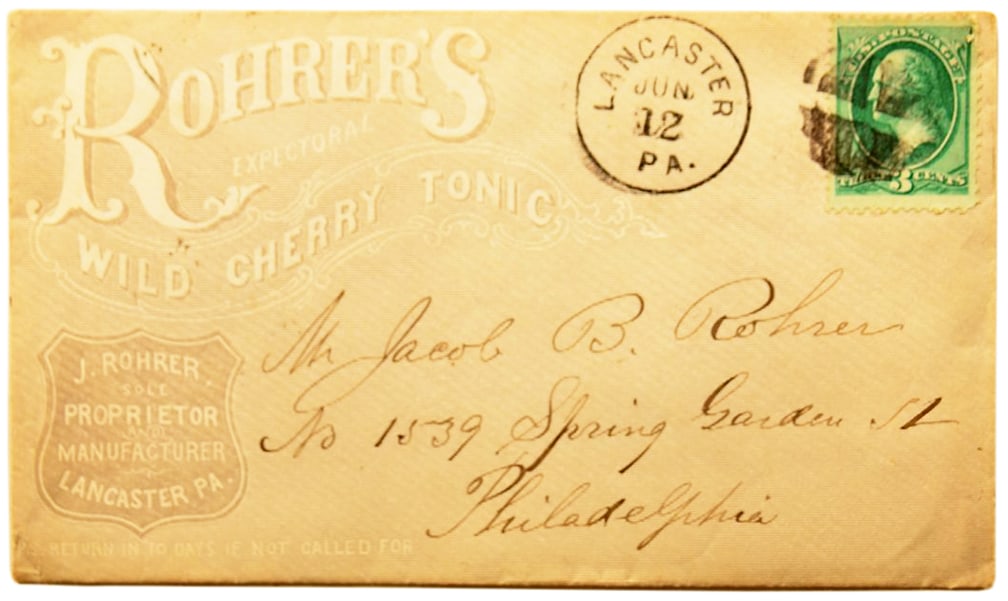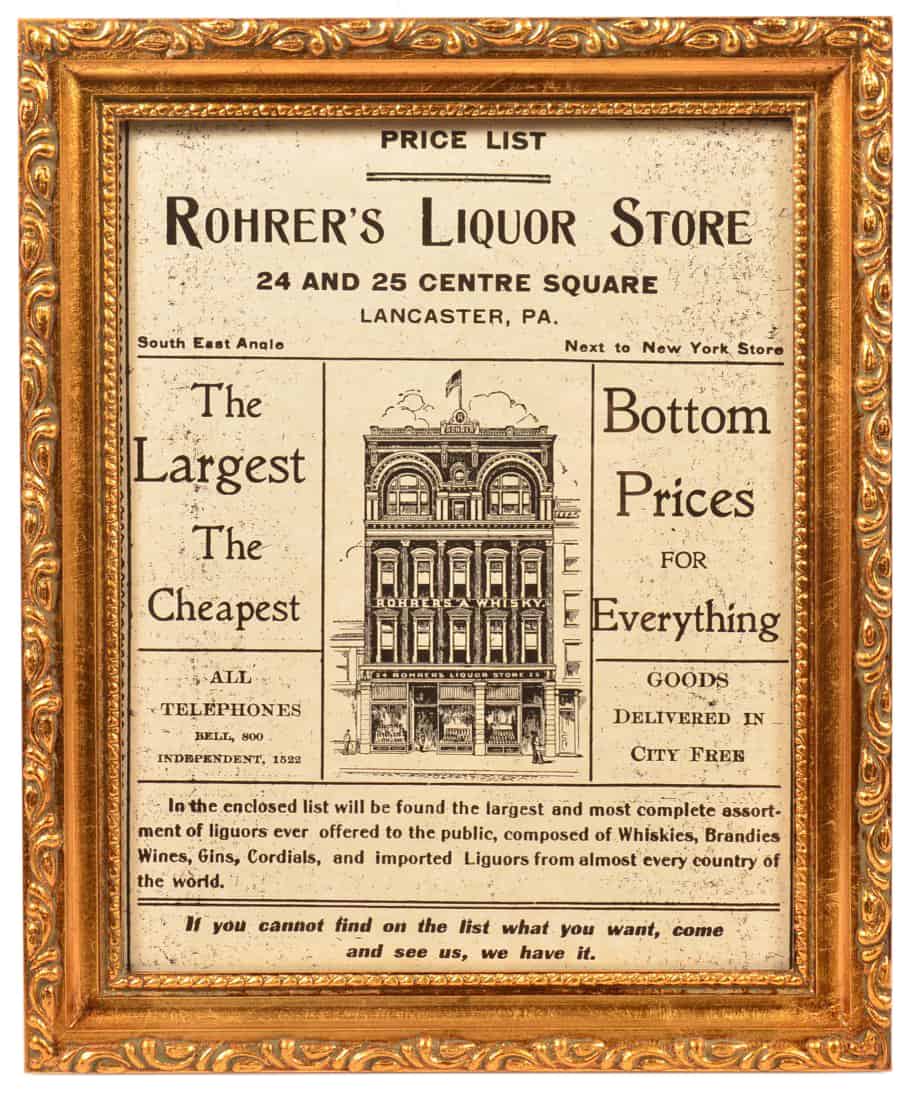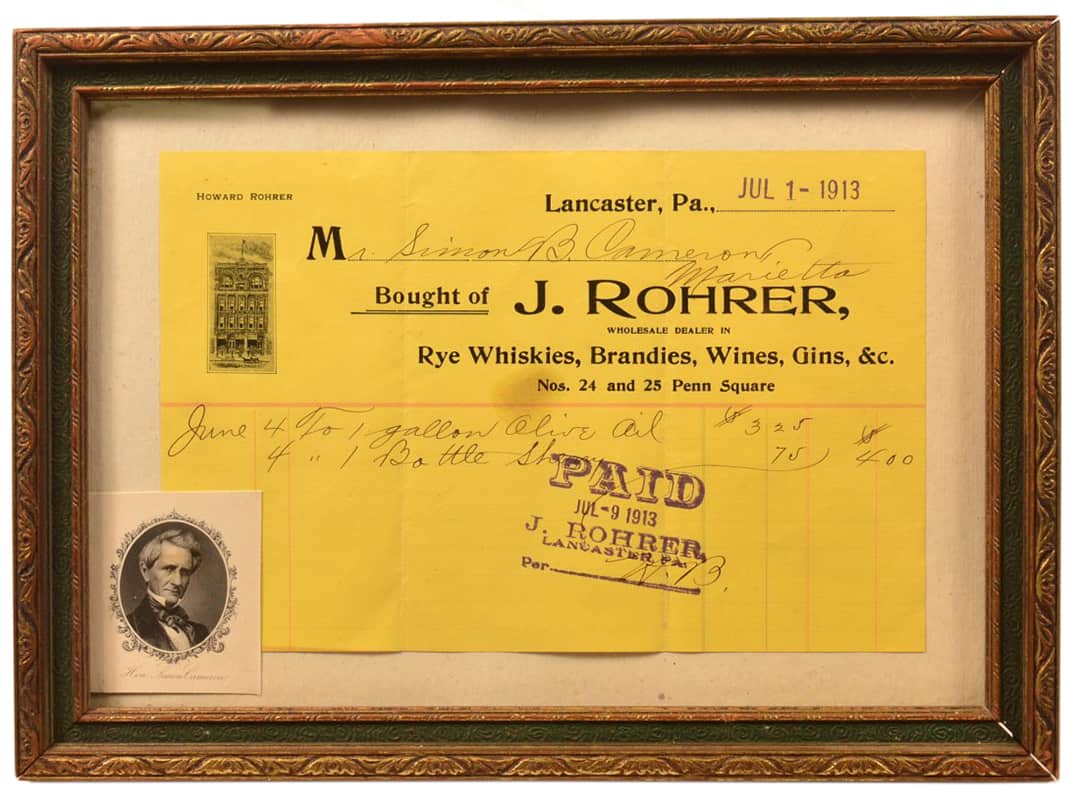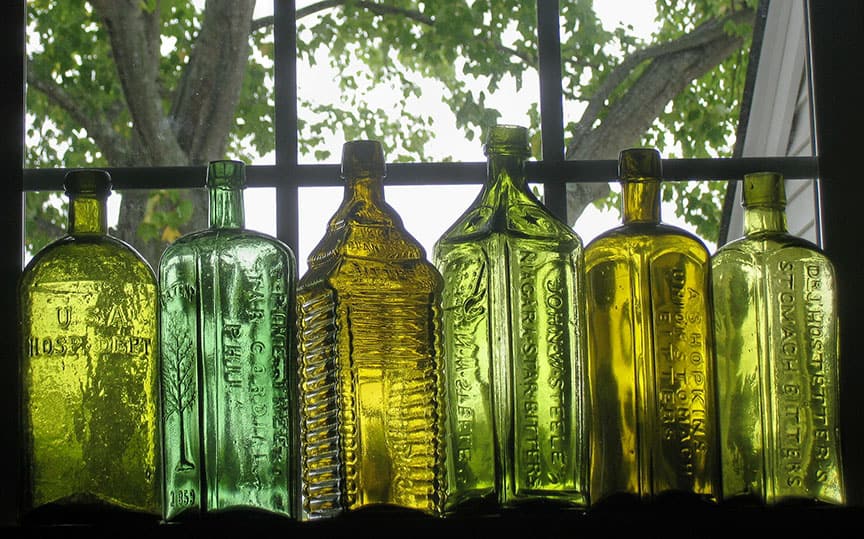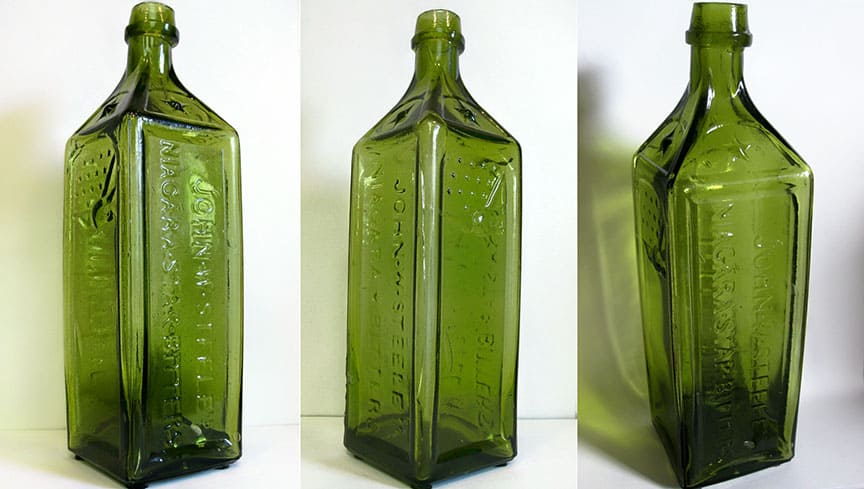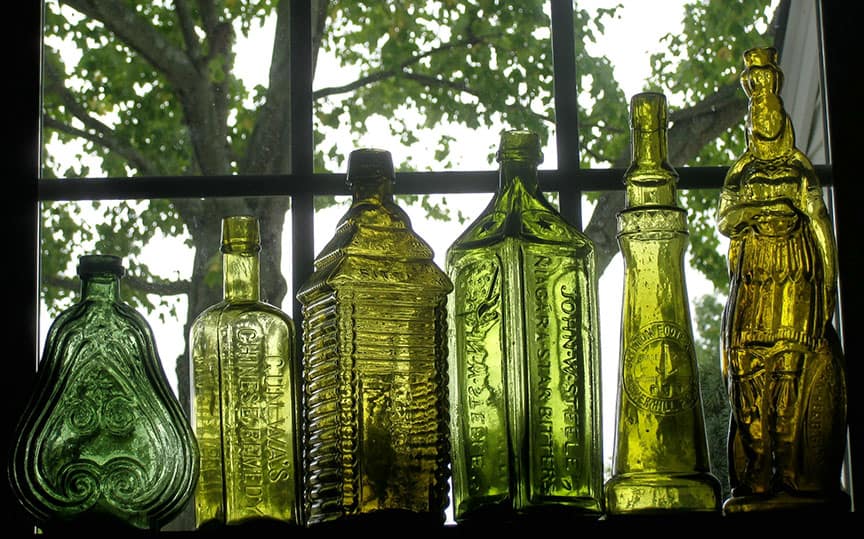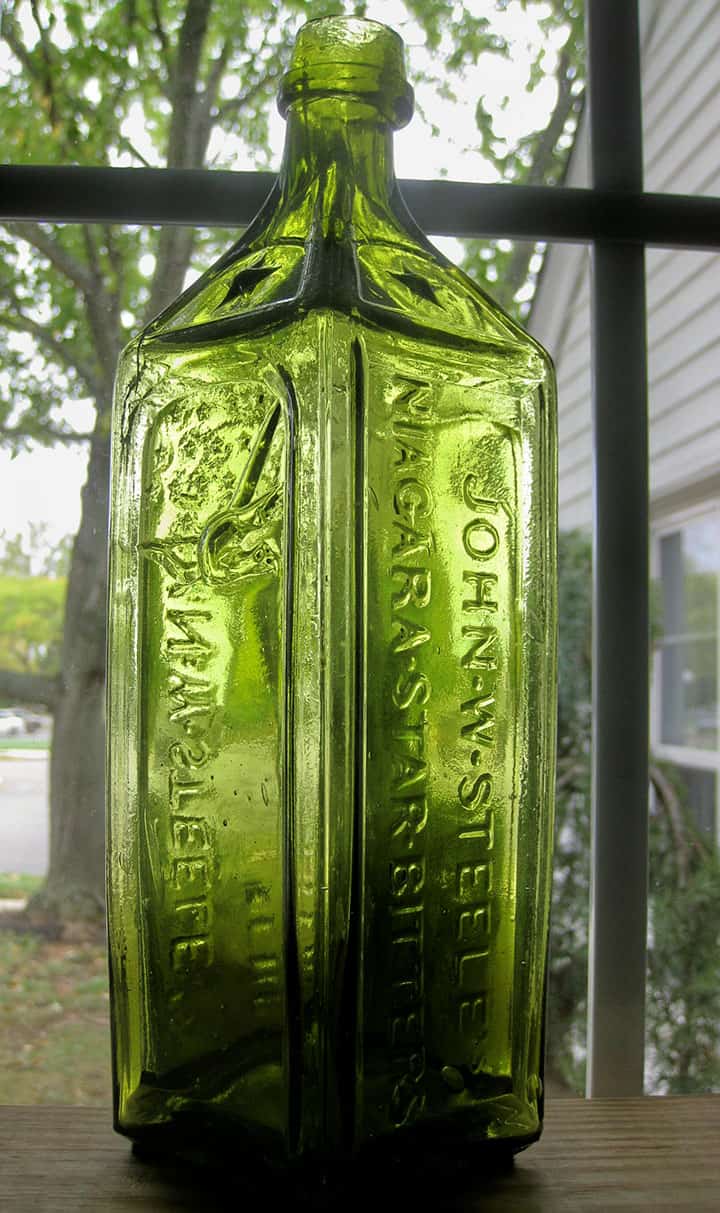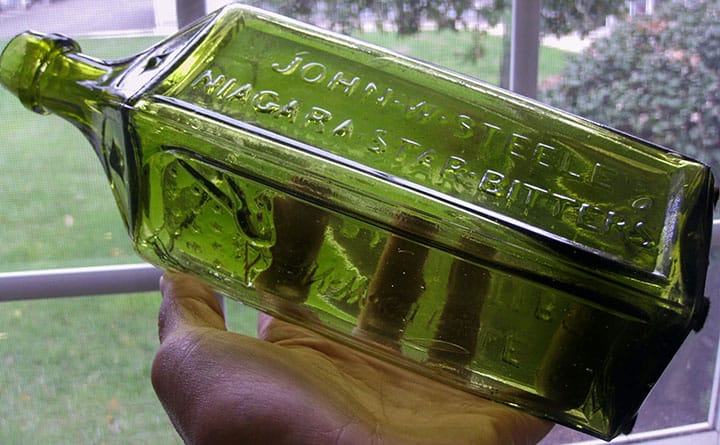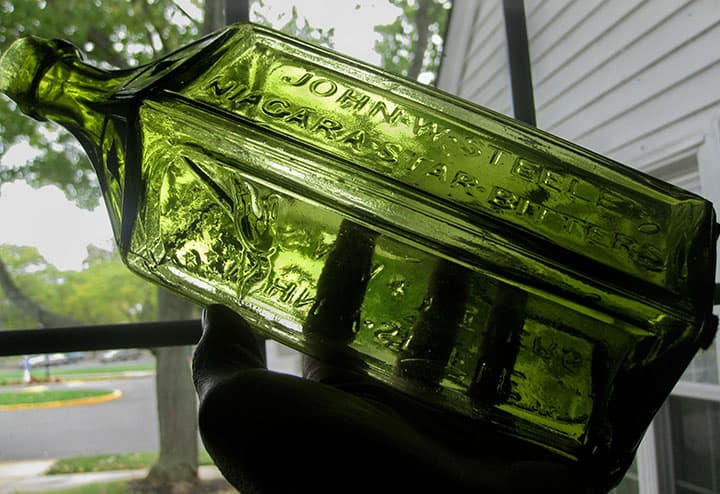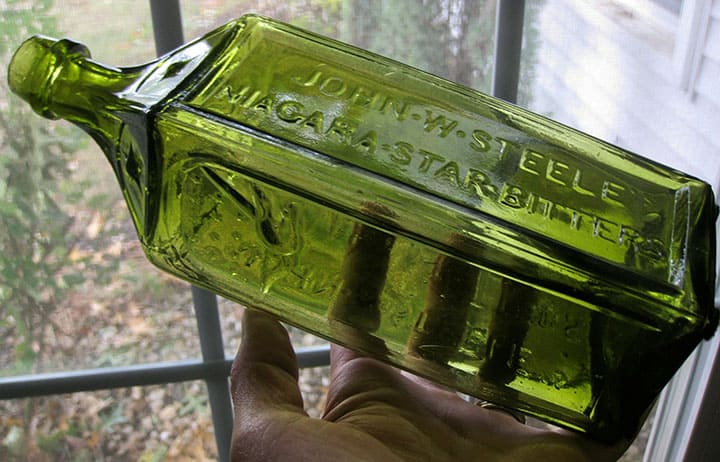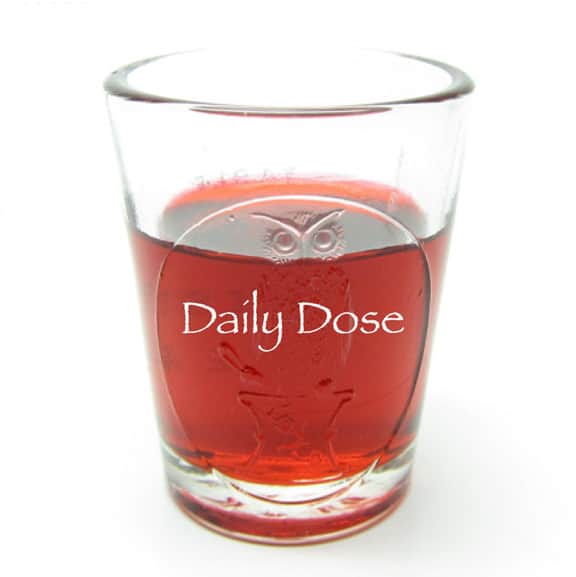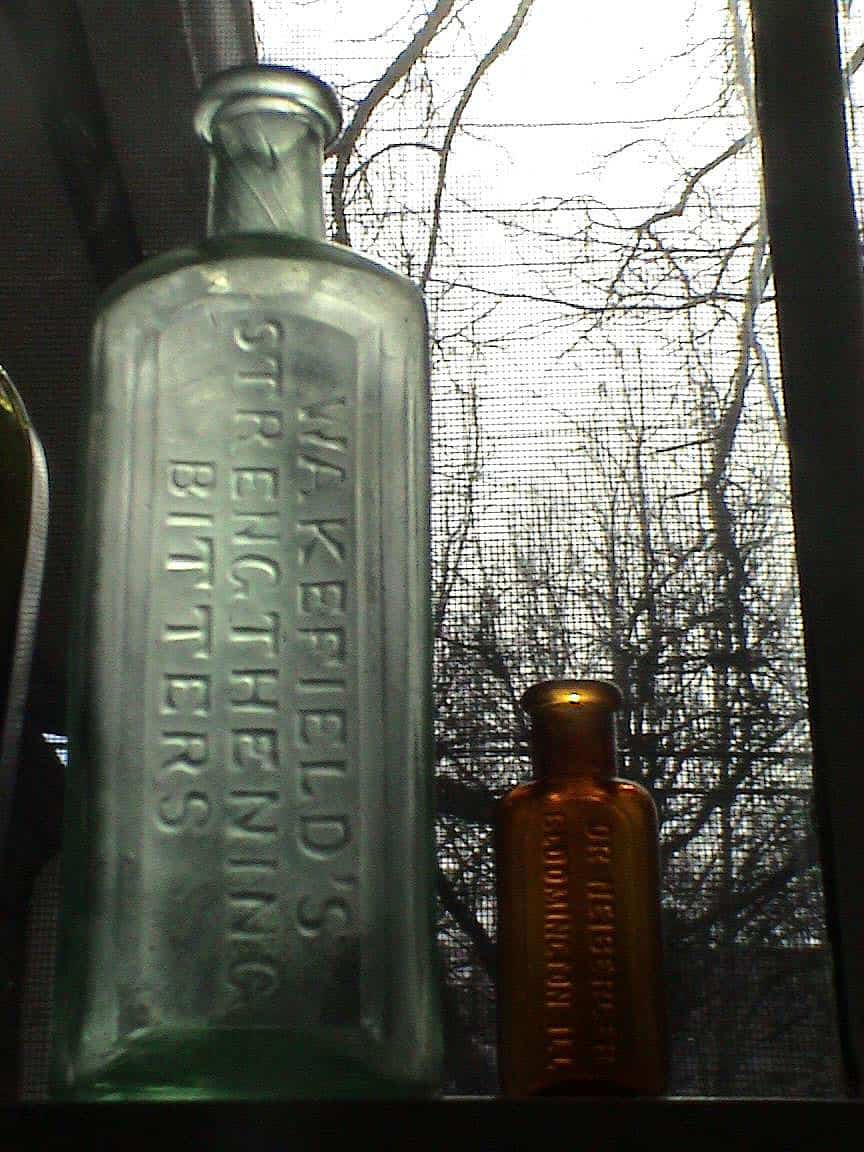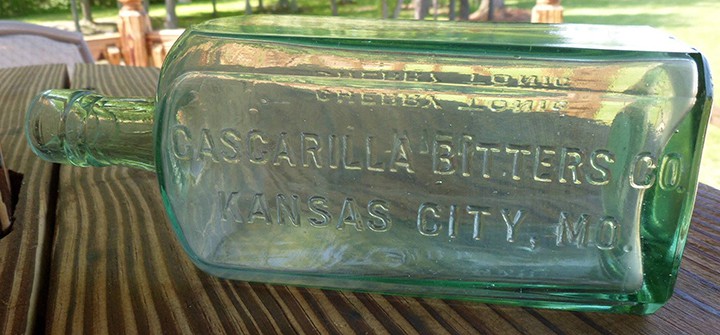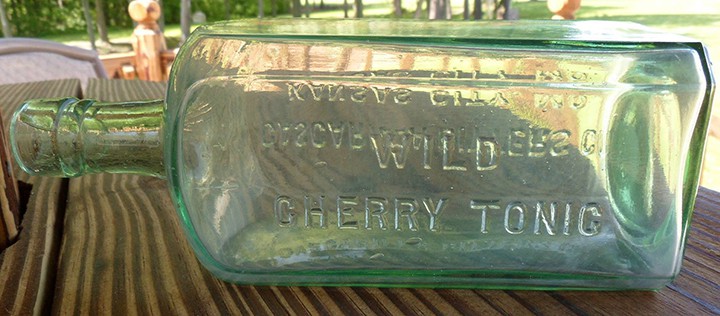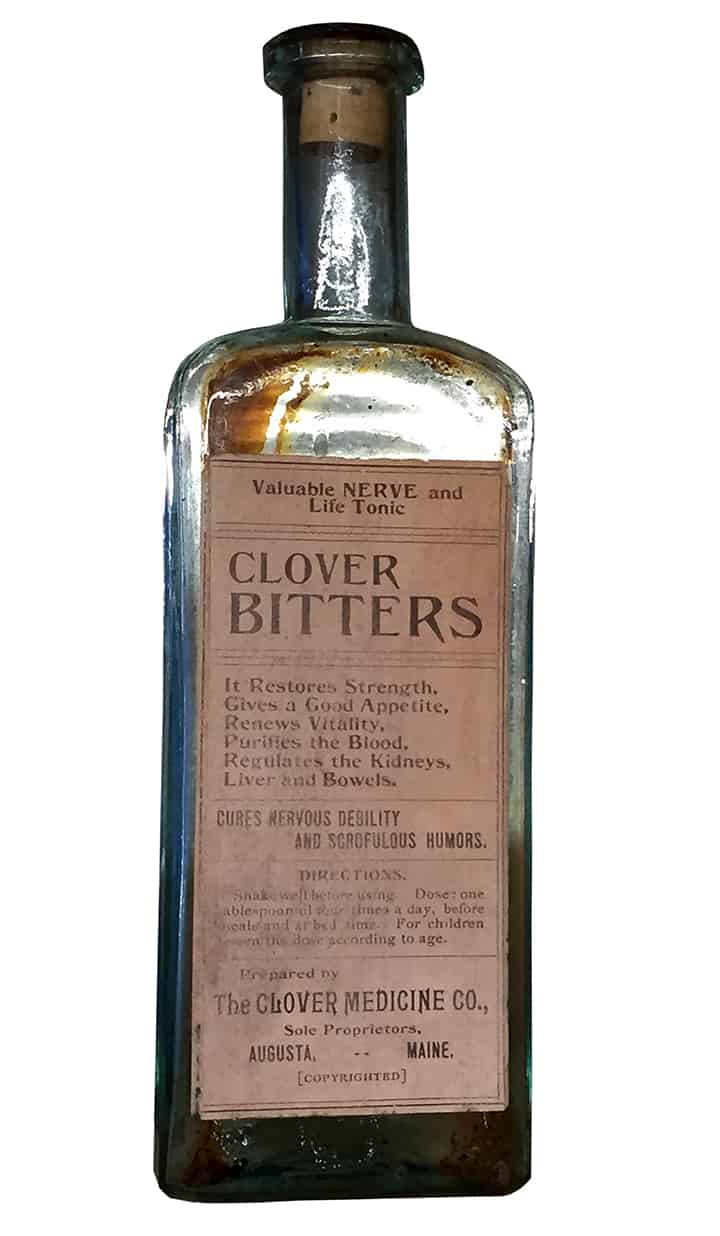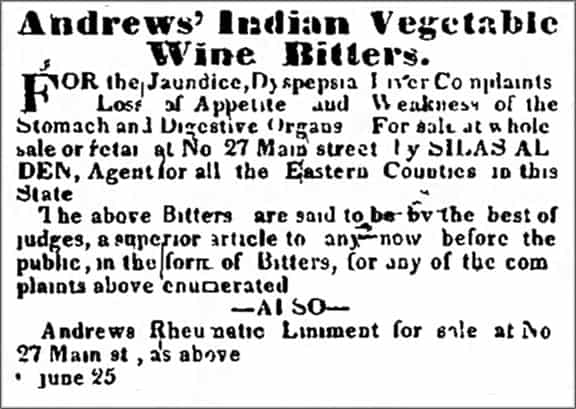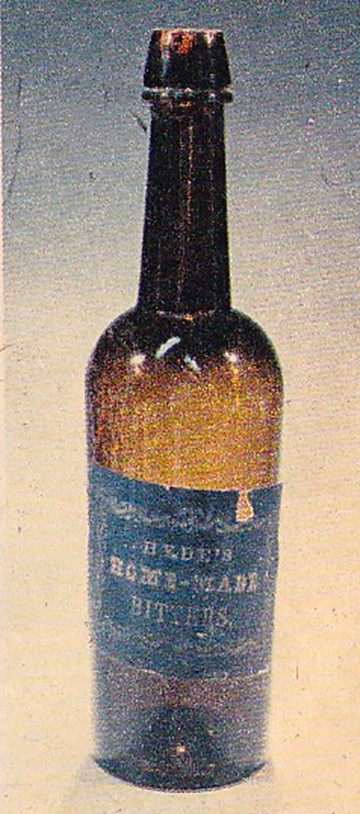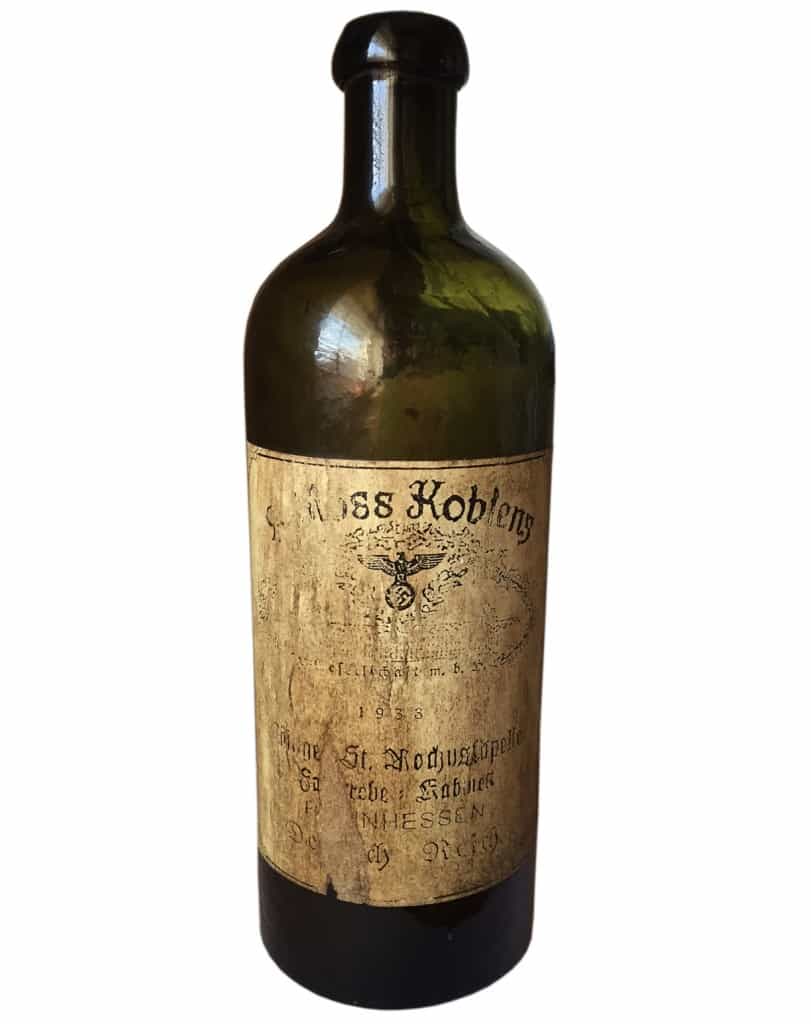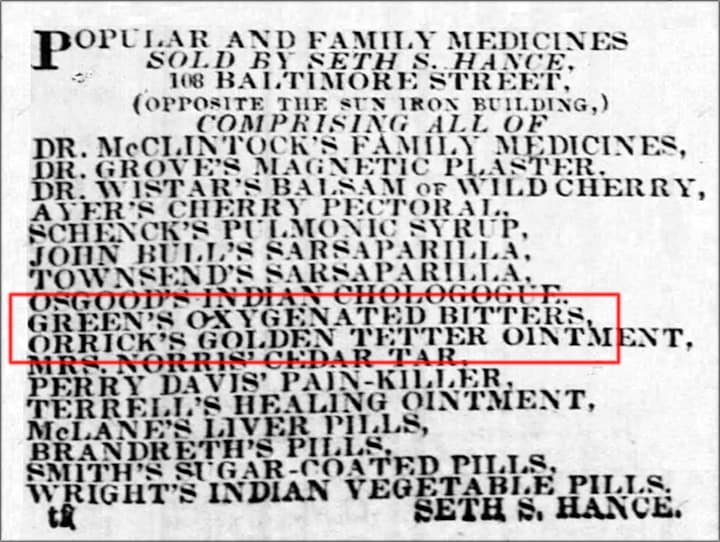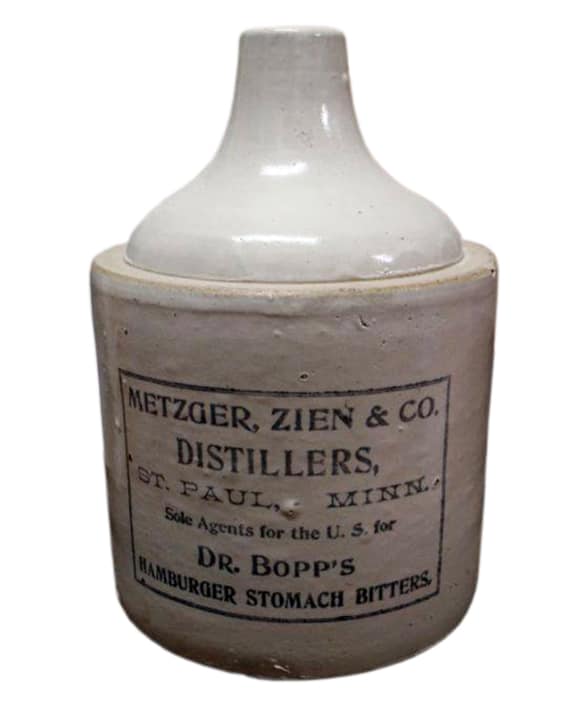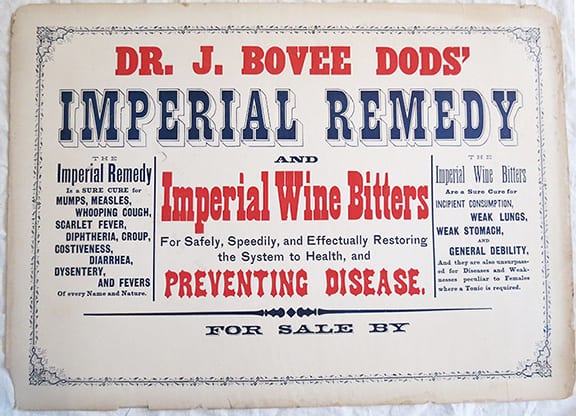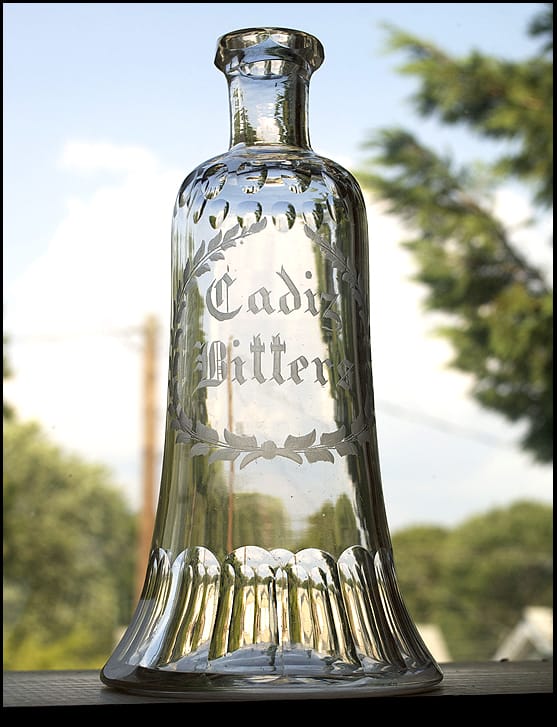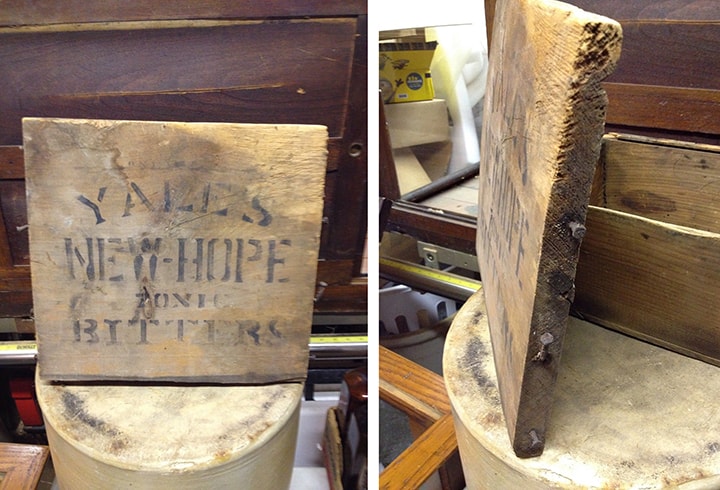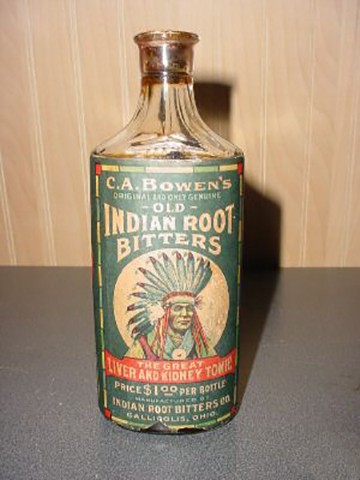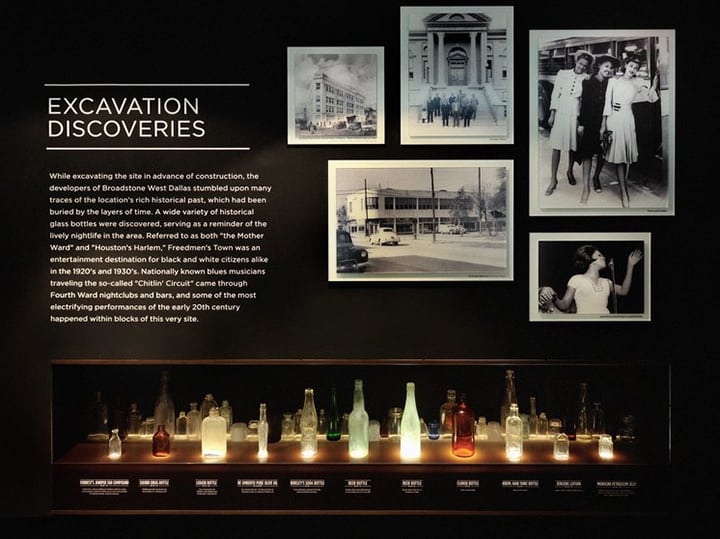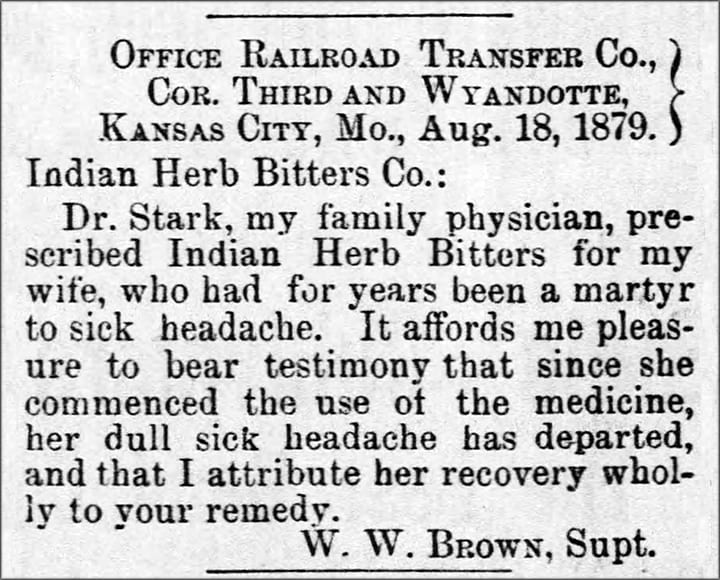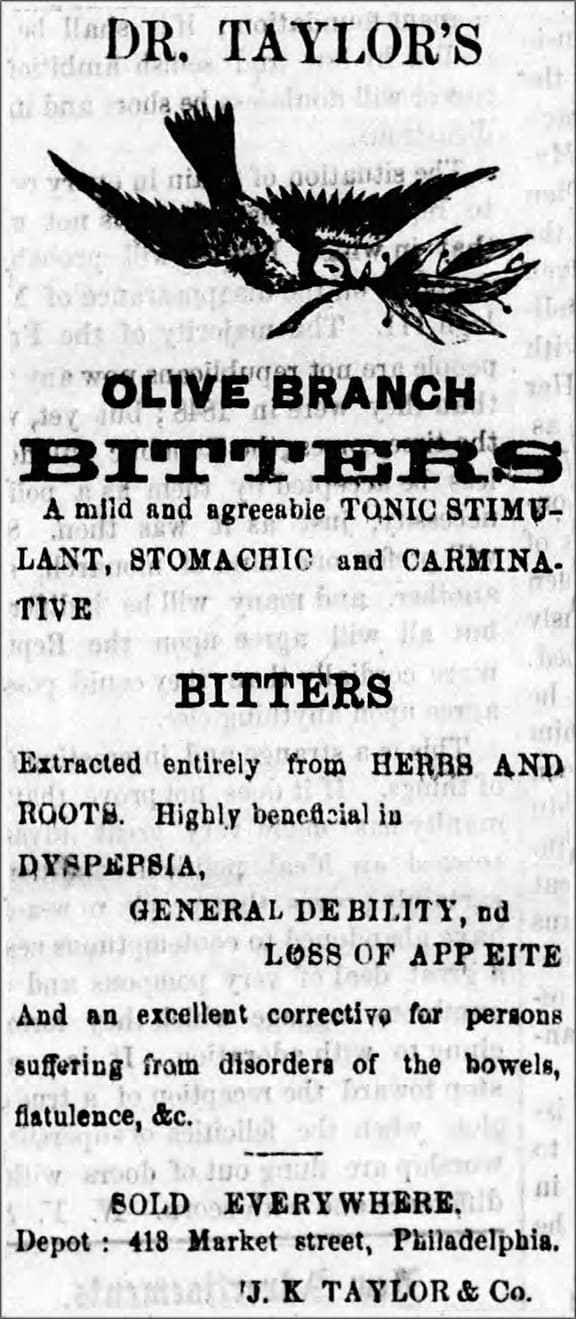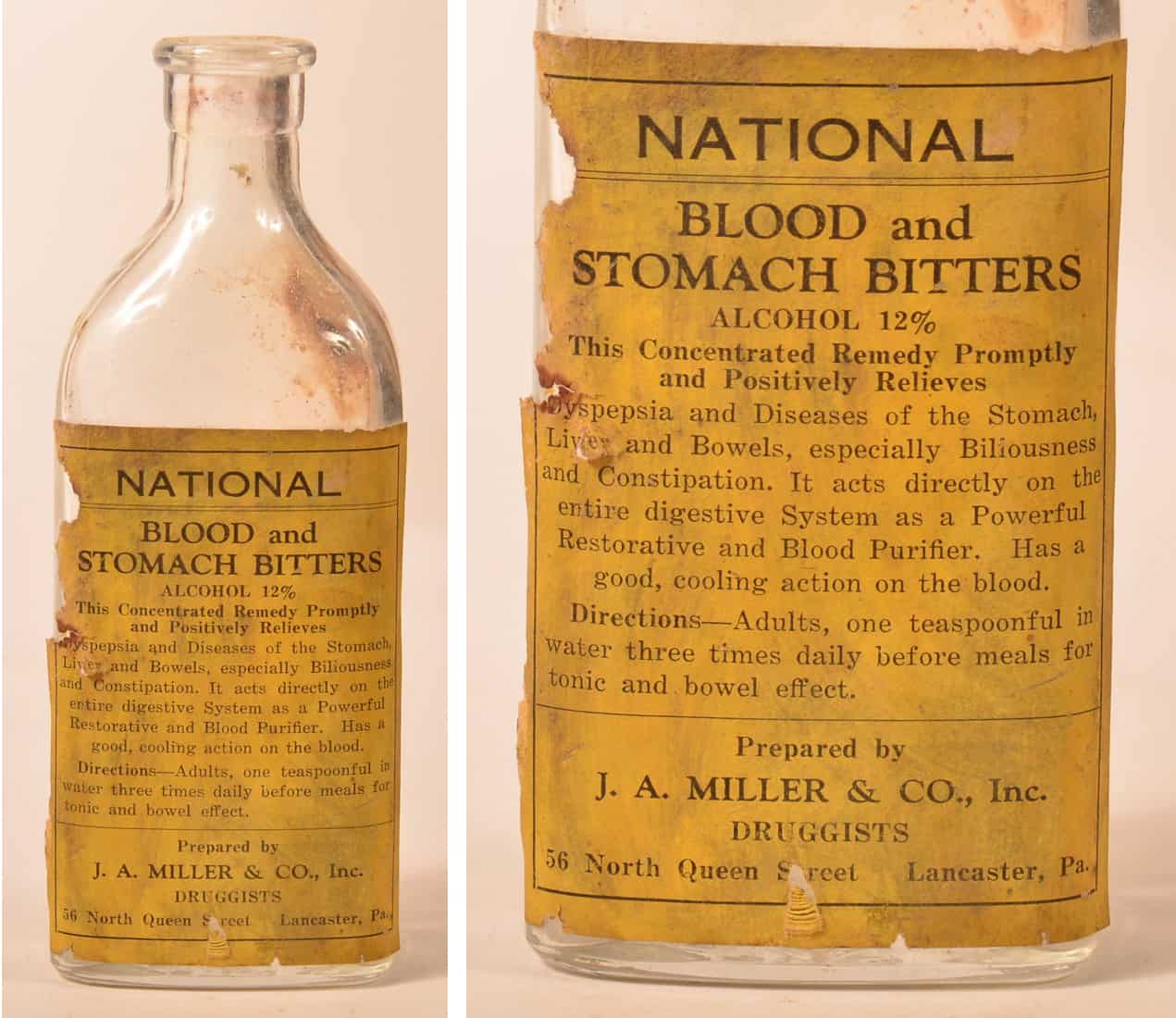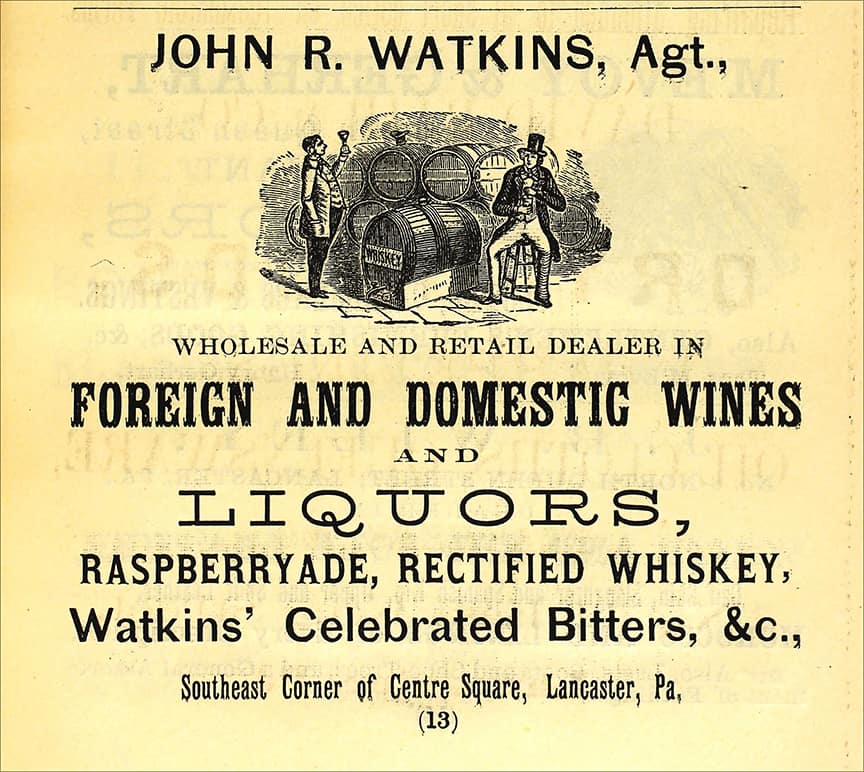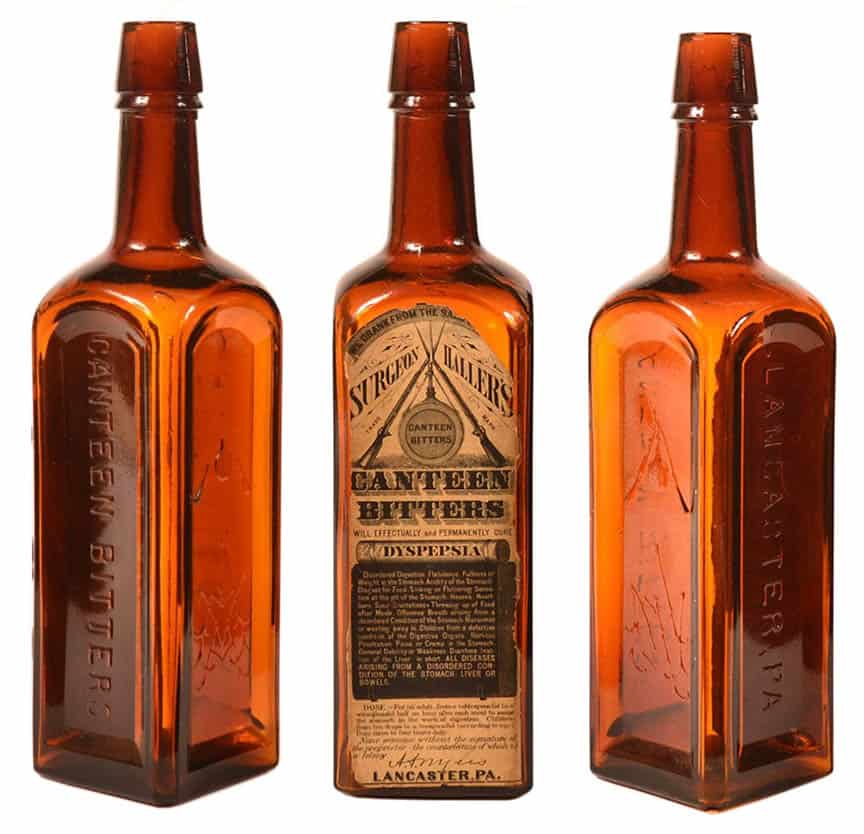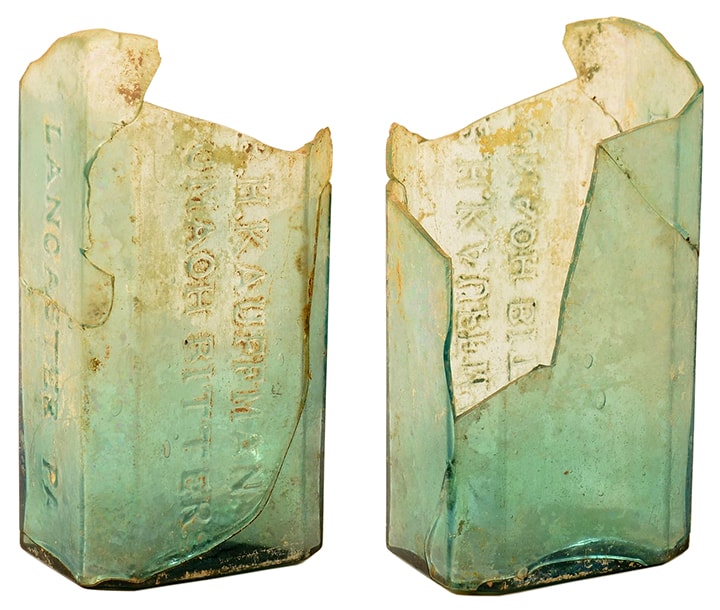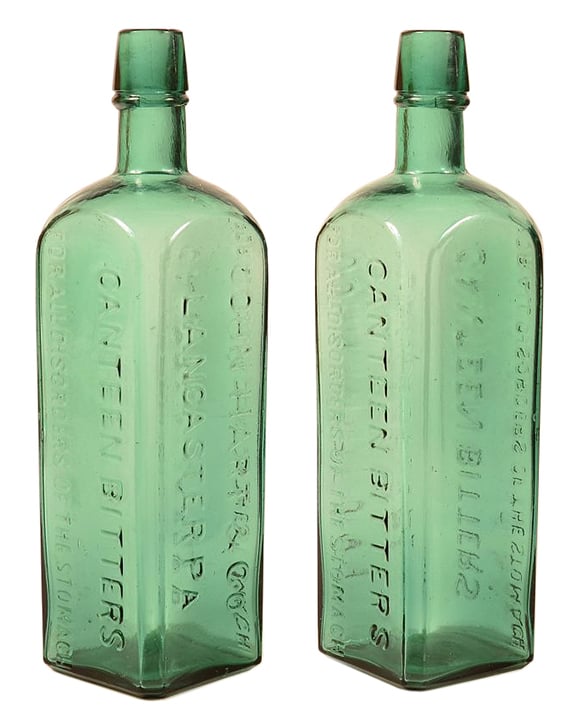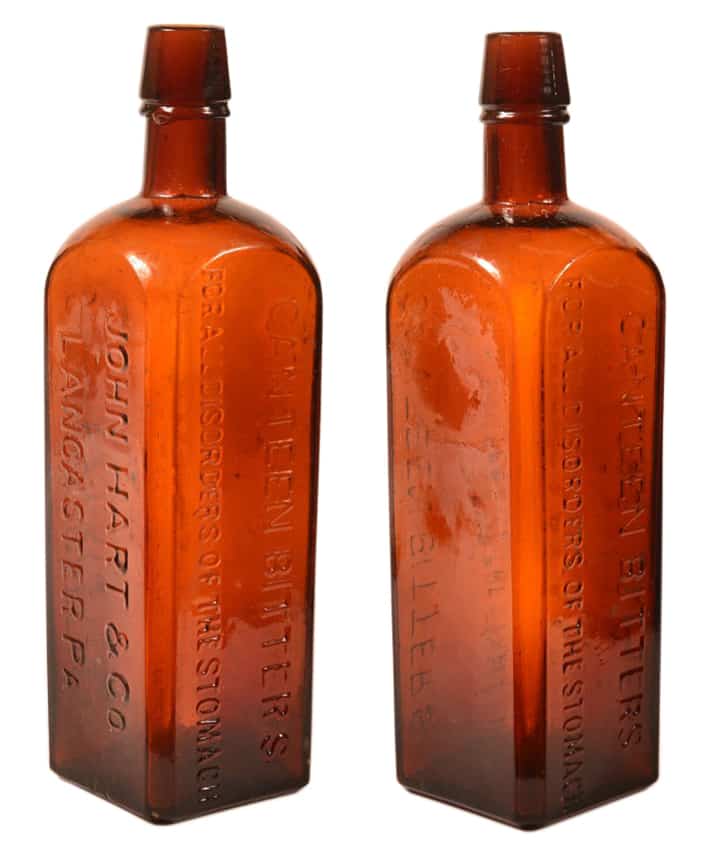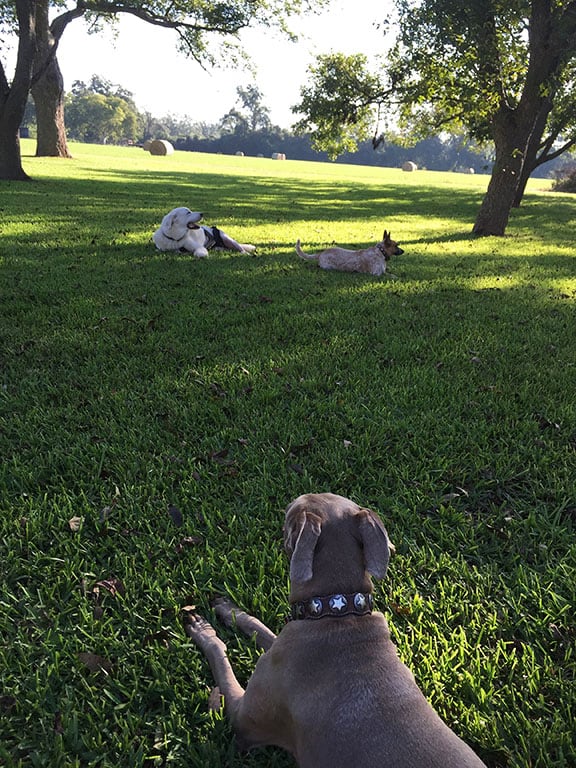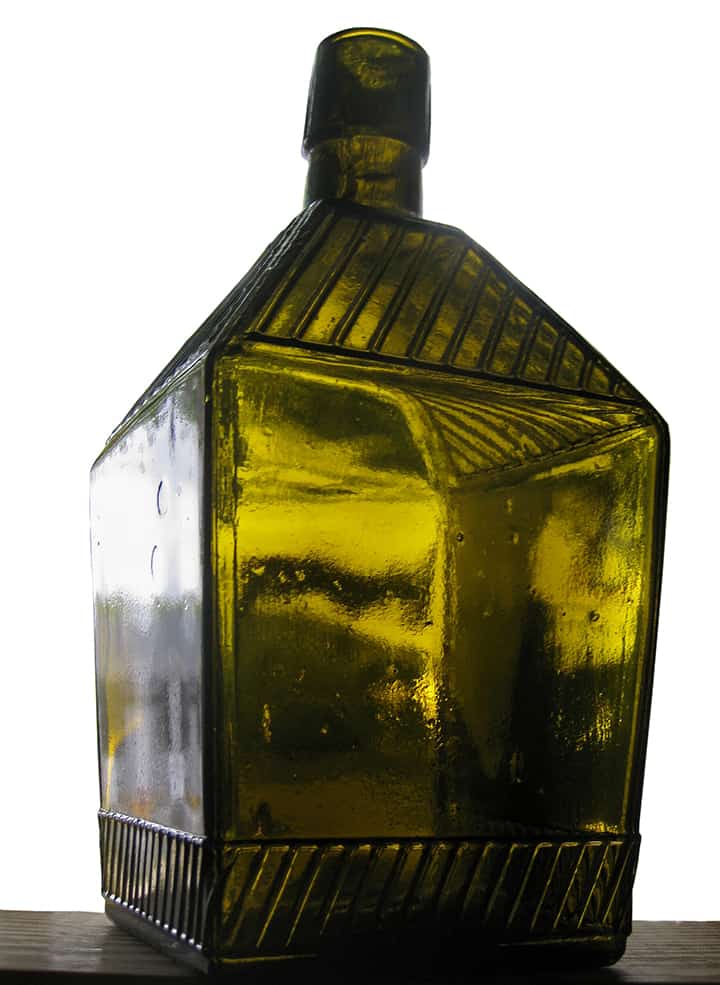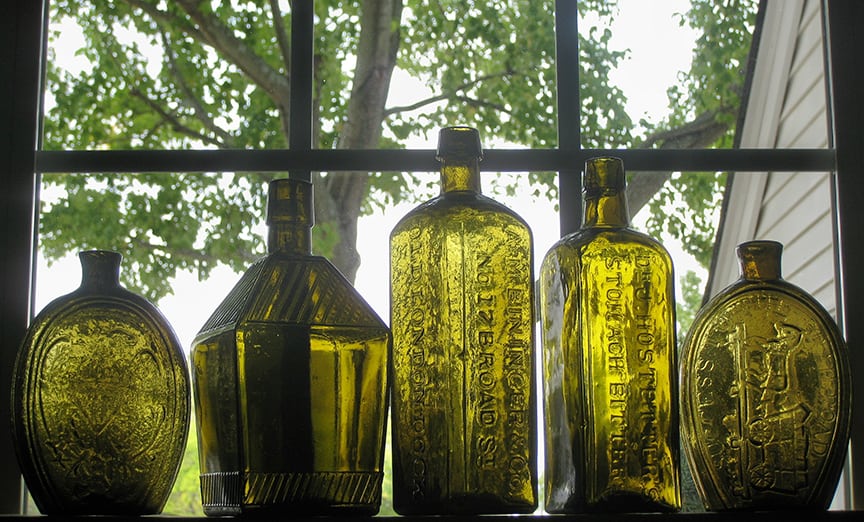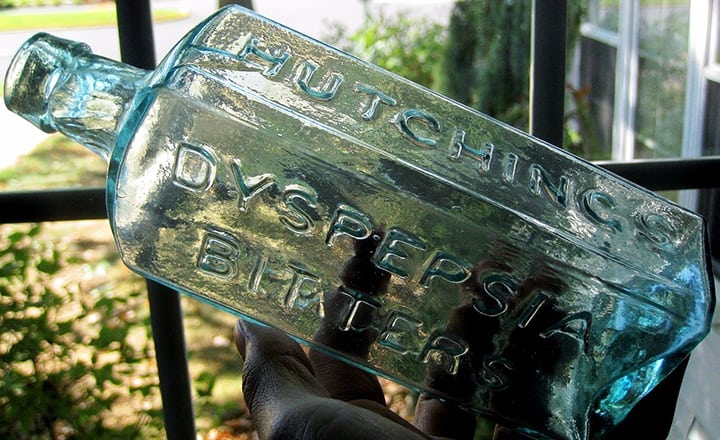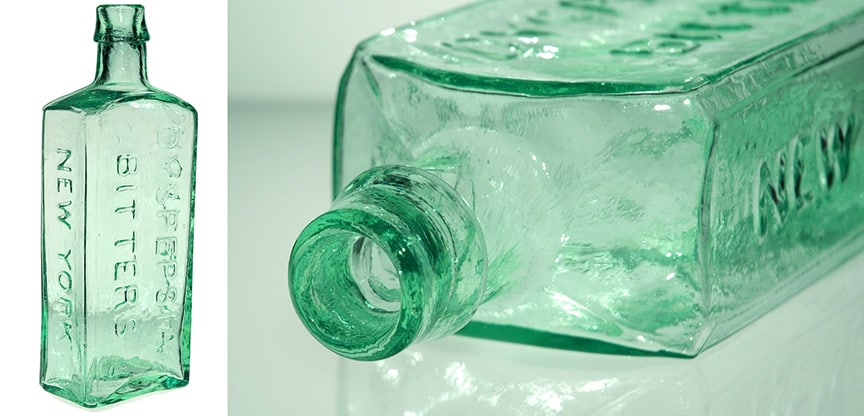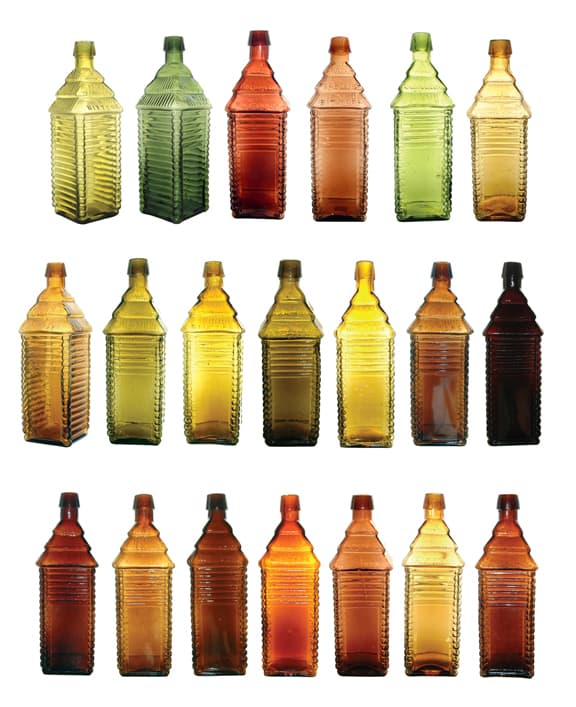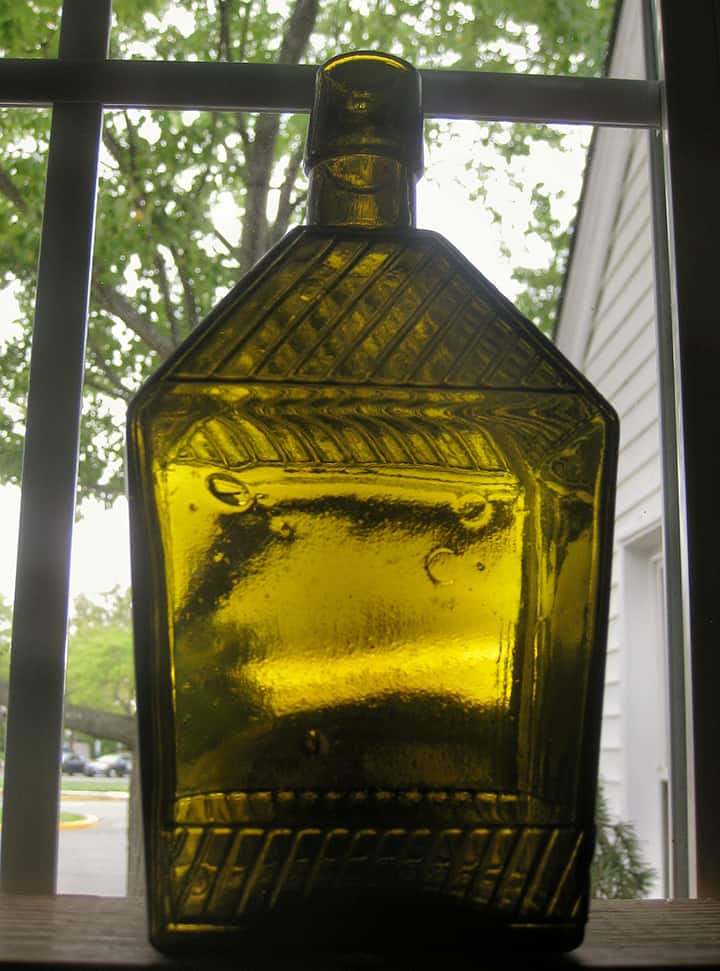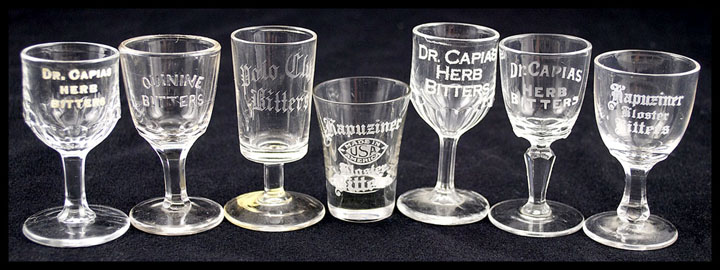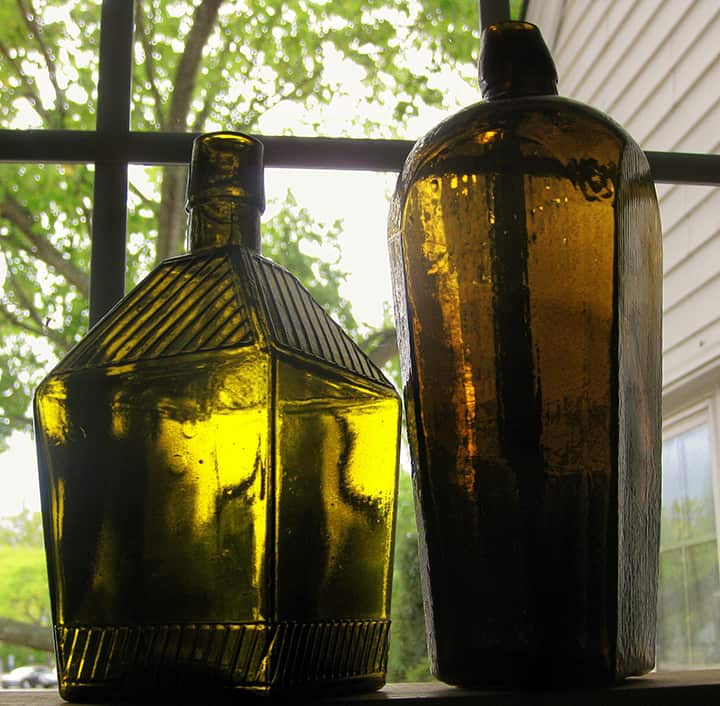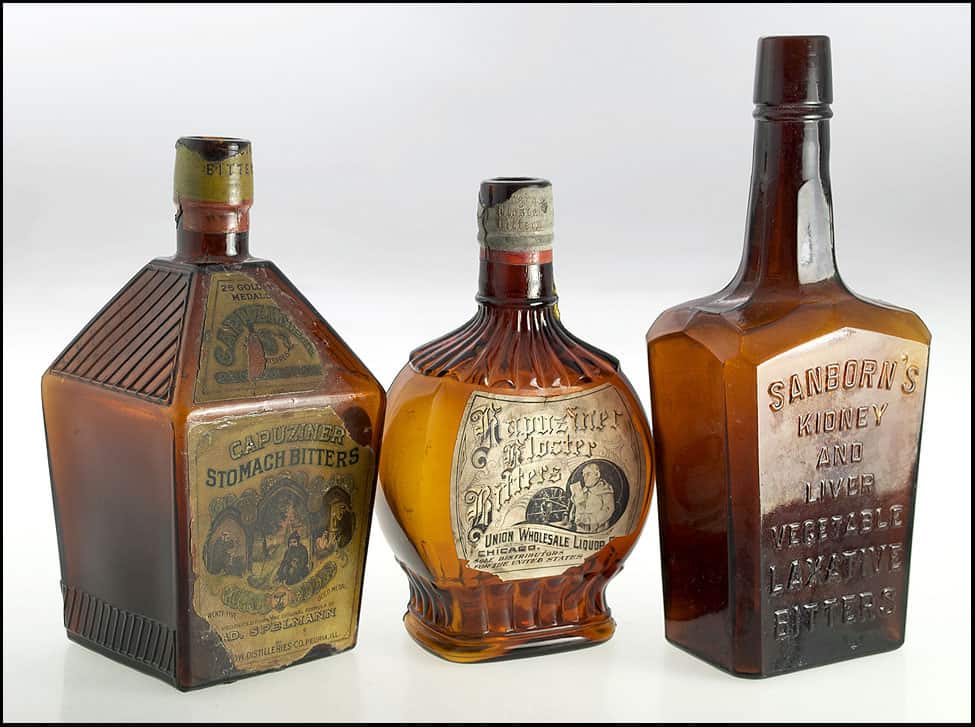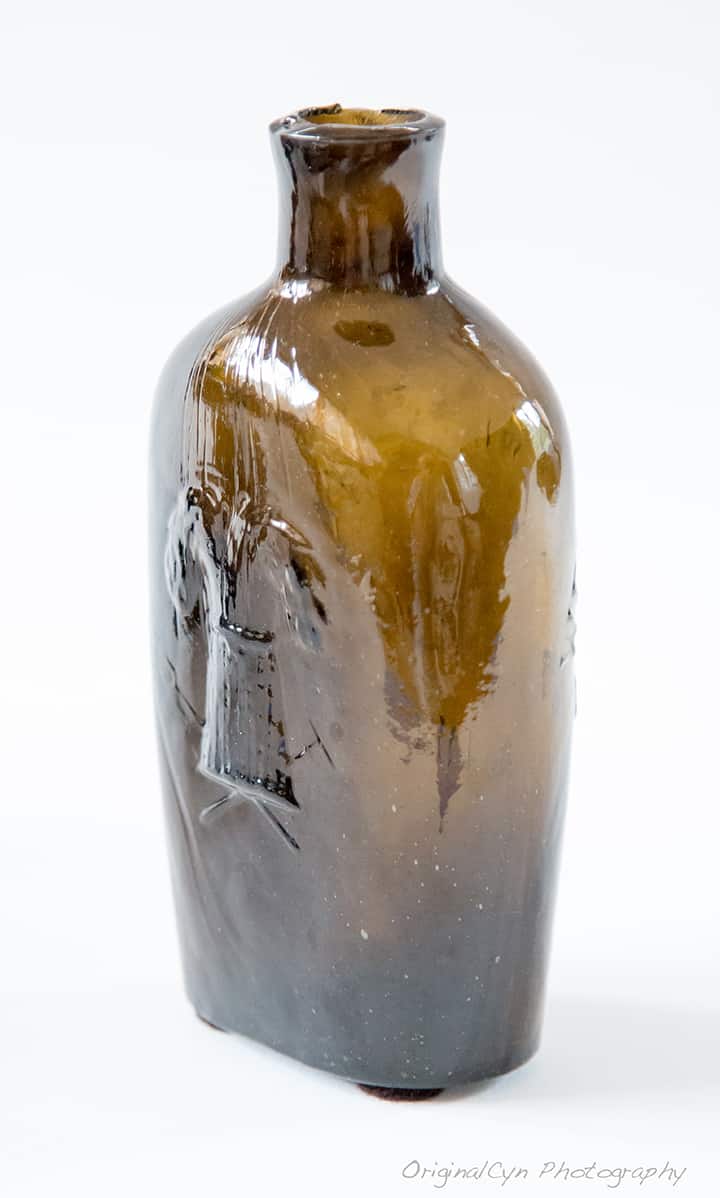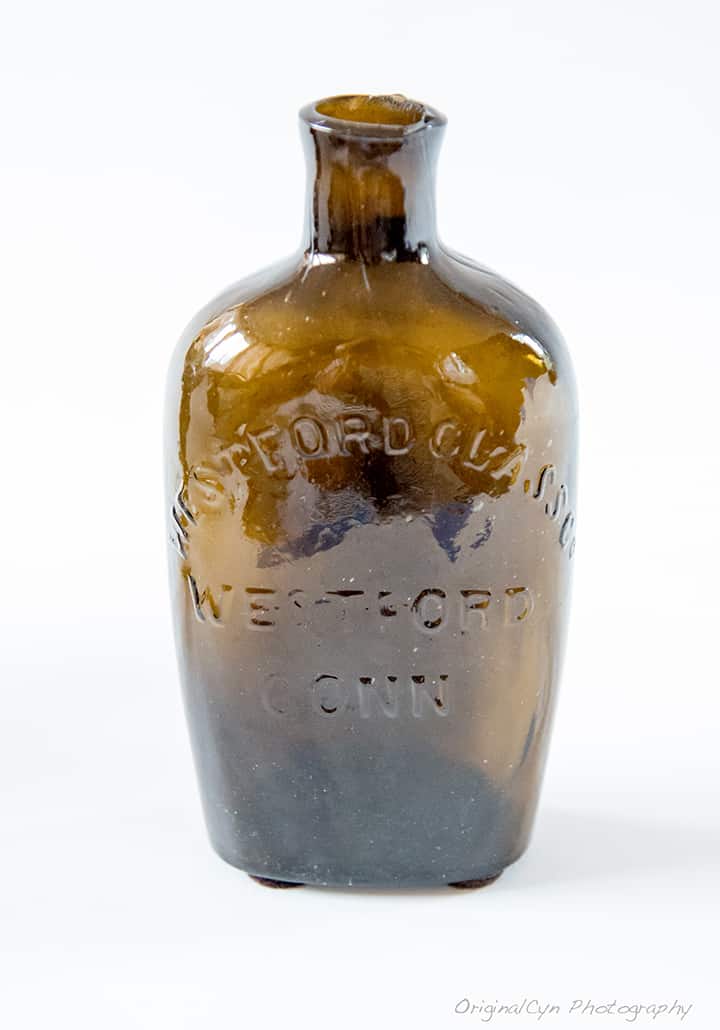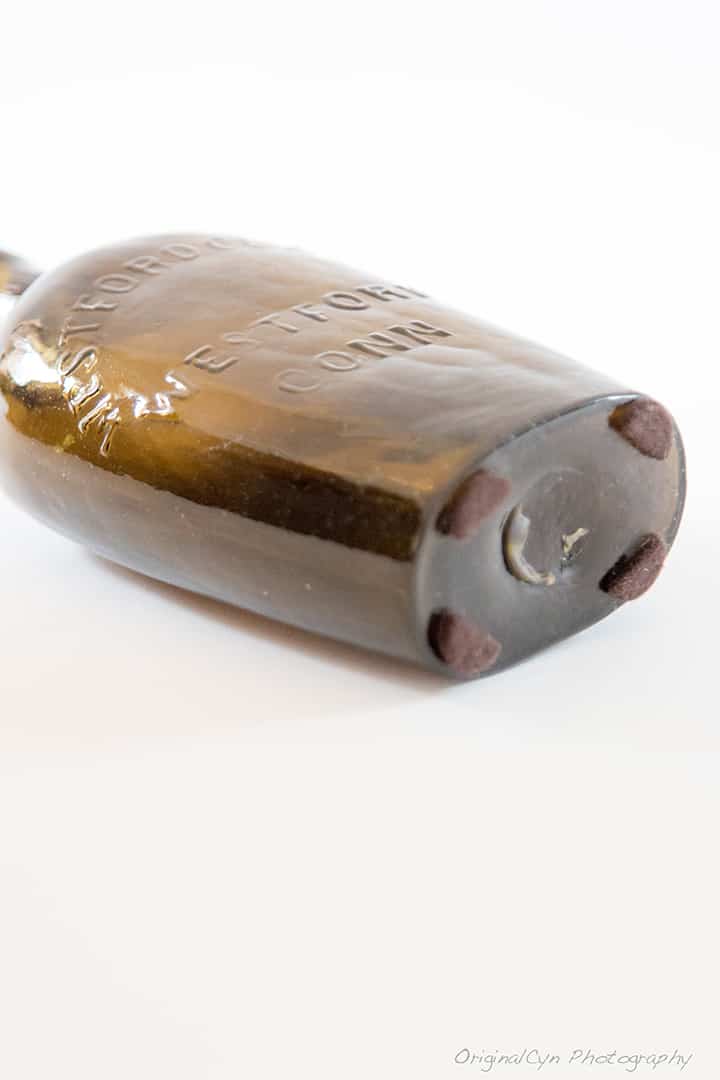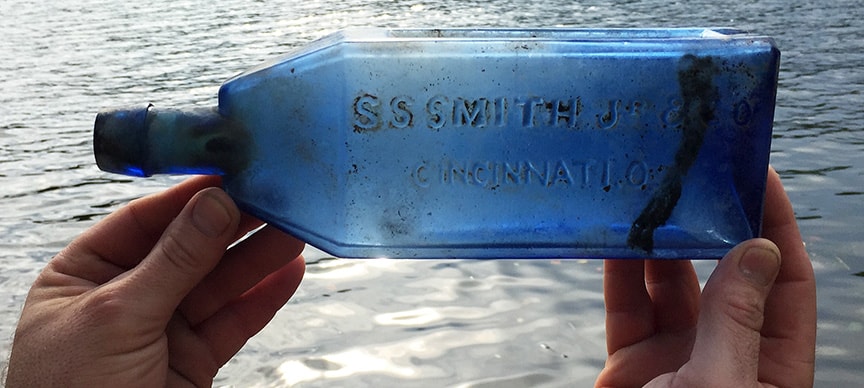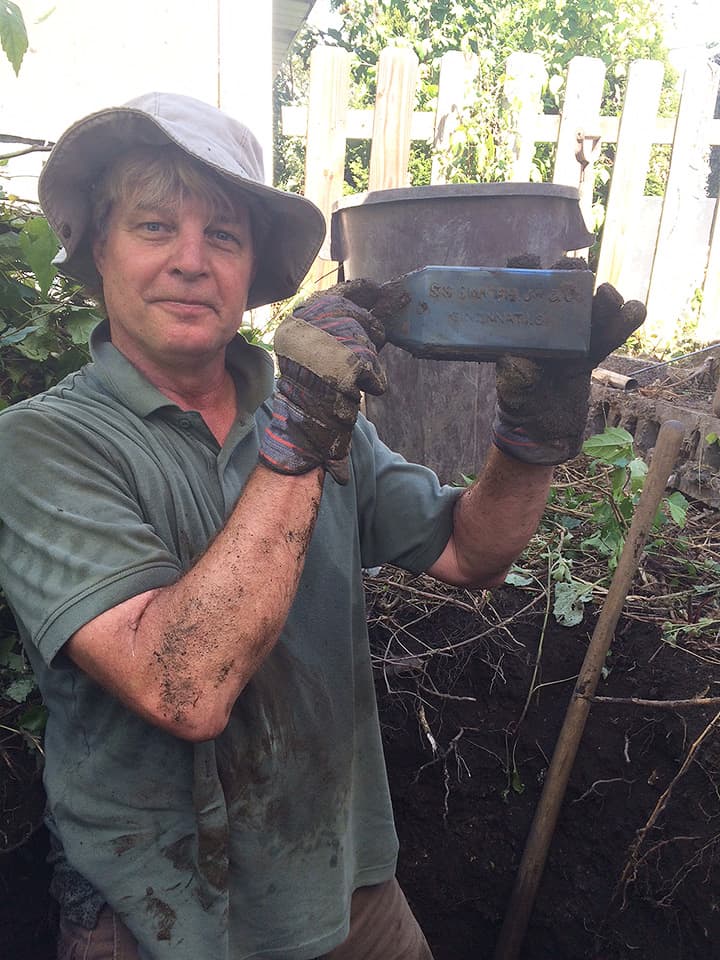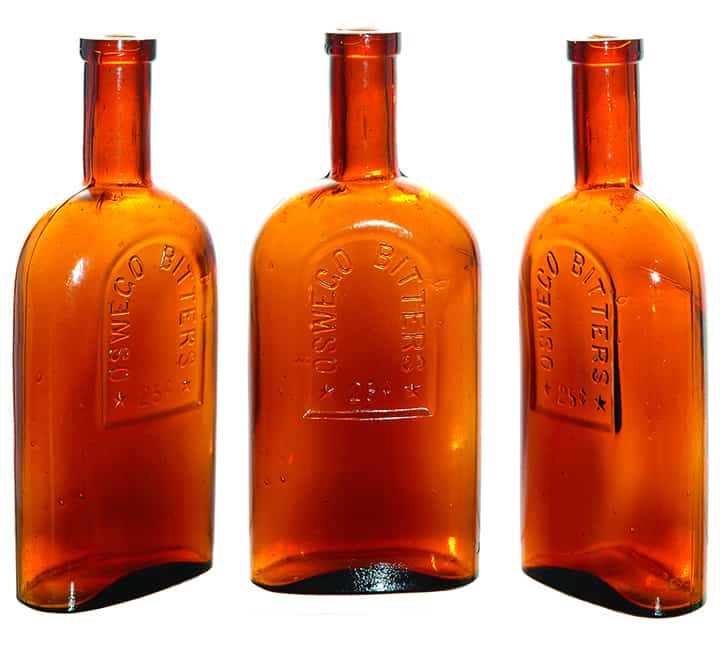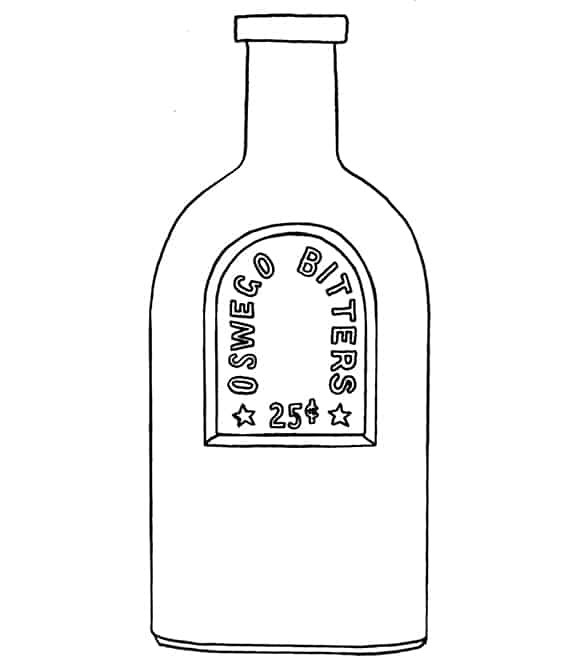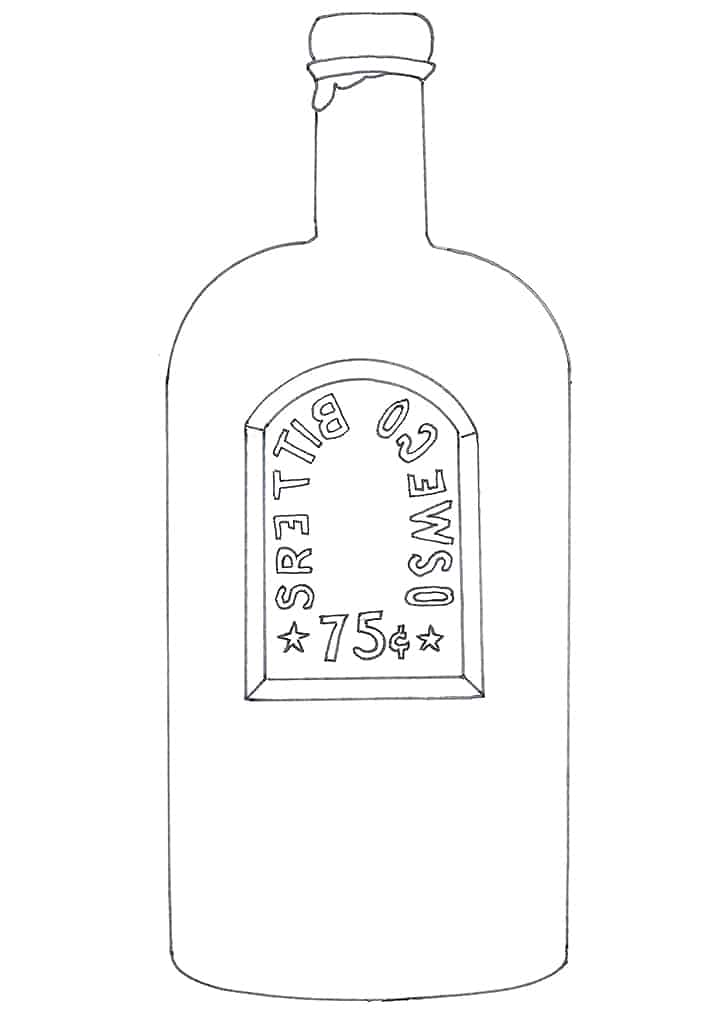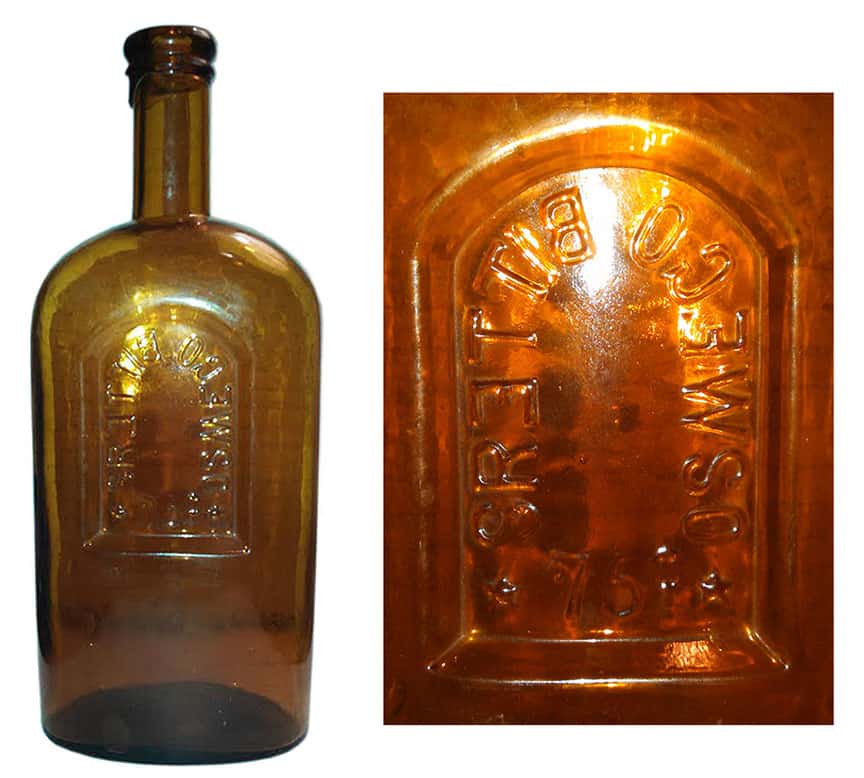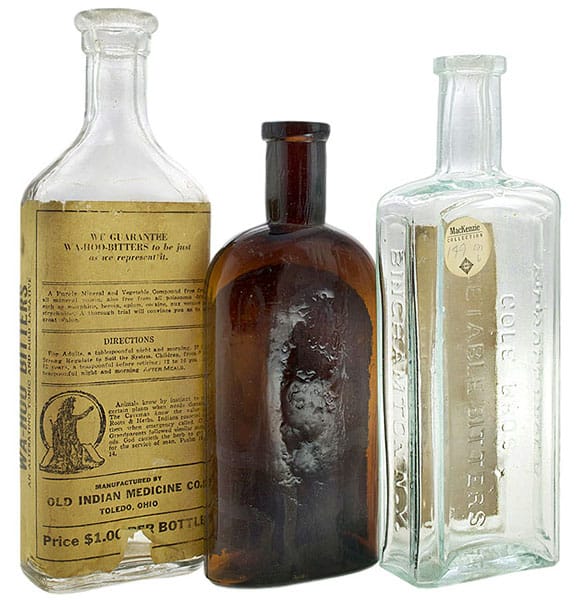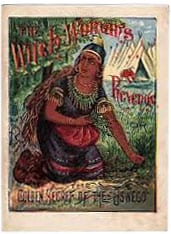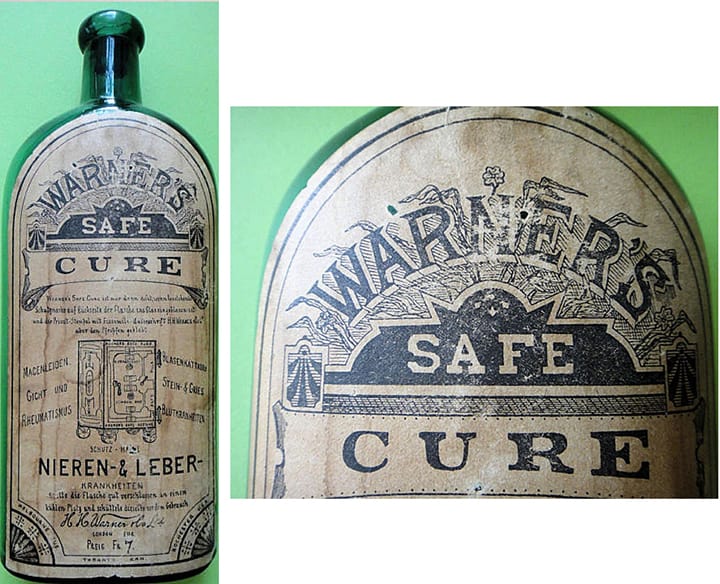Mishler’s Herb Bitters and the Mishler Family
14 October 2015 (R•031319) (R8042919 – information Dale P. Mishler). (R•051119 – Swanson covers)
If you are a bitters collector, you probably possess a bottle or two of the celebrated Mishler’s Herb Bitters on your shelves. The Great Household Remedy. Very popular and with many variants. Most are recognizable with the motif of a ruler with ounce table-spoon graduation graphics as you can see on the picture below. Pretty cool.
Where it gets more complicated is with the bottle panel embossing variants, base embossings and the Mishler family names associated with specific brands.
Researchers generally agree that the Mishler family immigrated on the ship Phoenix which arrived in Philadelphia on September 15, 1749. On that ship list are the names of Jacob Mishler, who signed with an X, followed by Joseph Mishler (the first Mishler of this posts family line), who was born in 1757 in Switzerland. Joseph was the father of John and the grandfather of Benjamin. Joseph and John are buried in Denver Union (Denver Mennonite) Cemetery, Lancaster County, PA.
Benjamin Mishler was born on August 12, 1814 in Reamstown, Pennsylvania which is sixteen miles northeast of Lancaster, Pennsylvania on the Reading Pike. His parents were John Mishler and Maria Reinhold. Mishler advertising supports that in 1855, Benjamin and his brother Isaac were in the liquor business and had a distillery in East Cocalico Township, three miles northwest of Reamstown called Old Lion Brewery & Distillery. At this time, Mishler’s Herb Bitters was introduced by Benjamin. In 1859 he sold his distilling interest to Isaac and pursued Mishler’s Herb Bitters in earnest. He also magically becomes Dr. Benjamin Mishler. The manufacturing was carried out in a building on the southeast corner of Centre Square, now called Penn Square, in the very heart of Lancaster. He was so proud and confident of his bitters that he routinely placed advertisements offering monetary rewards to any other doctors or members of the medical community if they could prove they had a better medicine than his Mishler’s Herb Bitters.
Then there is the extremely rare Mishler’s Keystone Bitters put out by Henry L. Mishler, the Mishler’s Wild Cherry Tonic Bitters made by Evan Mishler and Dr. Samuel B. Hartman who later took over the Mishler Herb Bitters brand and had his name embossed on bottles. Then the brand was sold and reorganized with bottles embossed Mishler’s Herb Bitters Co. They even snuck in “German” and said Mishler’s German Herb Bitters in mid 1880 drug catalogs.
The Mishler’s Herb Bitters bottles are associated with Lancaster, Reading, Philadelphia and Pittsburgh to add to the mix. Besides Mishler’s Herb Bitters, there are even sub brands like Mishler’s Red Label Bitters and Mishler’s Green Label Bitters. The bottles also come in some exciting amber and yellow colors. I know, all over the place here.
The advertising collectors have tons to keep up with here as there are lots of Mishler advertising trade cards to keep them busy. For revenue stamp collectors, like myself, during the time period from July 1862 to March 1883, 968, 996 stamps were affixed to bottles of Mishler’s Herb Bitters.
We even have family scandal as Benjamin Mishler took advertisements out to say that his son Henry had ripped off the brand and was selling an imposter. Doesn’t get much better than this in the bitters world.
Read More: Mishler’s Herb Bitters Advertising Wall Clock
Read More: Mishler’s Keystone Bitters – Stencil and Bottle
Read More: Mishler’s Herb Bitters & Prof. Parker’s Pleasant Worm Syrup
The Players
Joseph Mishler
Joseph Mishler (the first Mishler of this family line) was born in 1757 in Switzerland. Joseph was the father of John and the grandfather of Benjamin. Joseph and John are buried in Denver Union (Denver Mennonite) Cemetery, Lancaster County, PA.
Benjamin Mishler
Benjamin Mishler was born on August 12, 1814 in Reamstown, Pennsylvania which is sixteen miles northeast of Lancaster, Pennsylvania on the Reading Pike. His parents were John Mishler and Maria Reinhold. Mishler advertising supports that in 1855, Benjamin and his brother Isaac were in the liquor business and had a distillery in East Cocalico Township, three miles northwest of Reamstown called Old Lion Brewery & Distillery. At this time, Mishler’s Herb Bitters was introduced by Benjamin. In 1859 he sold his distilling interest to Isaac and pursued Mishler’s Herb Bitters in earnest. The manufacturing was carried out in a building on the southeast corner of Centre Square, now called Penn Square, in the very heart of Lancaster.
1814: Benjamin Mishler born on August 12, 1814 in Reamstown, Pennsylvania. His parents were John Mishler and Maria Reinhold.
1836: Benjamin Mishler married Elizabeth Lesher on August 25, 1836 in Lancaster, Pennsylvania.
1840: Benjamin Mishler, home West Cocalico, Lancaster, Pennsylvania – United States Federal Census
1850: Benjamin Mishler, born about 1814, age 36, dealer, home Lancaster North East Ward, Lancaster, Pennsylvania, wife Elizabeth (33), Children: Liman (10), Henry (8) and Hanna A. (6) – United States Federal Census
1853: Benjamin Mishler running Sunbury & Milton passenger stage coach line to and from Philadelphia. Various advertisements.
1855: Mishler’s Herb Bitters Established 1855 (according to trade card below)
1856: Benjamin Misher contracted by the Postmaster General to run stage coach lines between various cities from Lancaster, Pennsylvania.
1860: Benjamin Mishler, born about 1814, âge 46, liquor dealer, home Lancaster, North West Ward, Pennsylvania, wife Elizabeth (35), Children: Henry (17) and Hannah (16) – United States Federal Census
1863: MISHLER, BENJAMIN, liquors, Centre sq. n W. King, h S. Queen c Centre sq., Lancaster, PA. (see advertisement below) – Gopsill´s Directory of Lancaster, Harrisburg, Lebanon and York, 1863-64
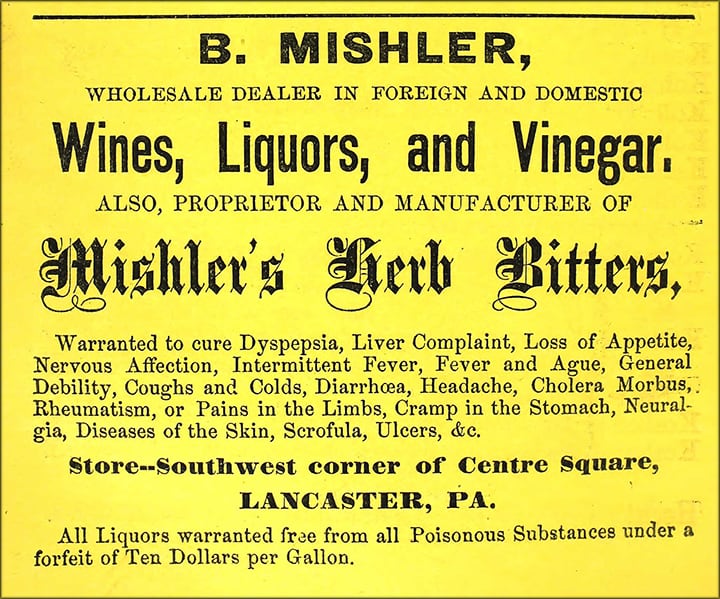
B. MISHLER, Mishler’s Herb Bitters, Wines, Liquors, Centre sq. n W. King, h S. Queen c Centre sq., Lancaster, PA. – Gopsill´s Directory of Lancaster, Harrisburg, Lebanon and York, 1863-64
1867: Samuel B. Hartman purchased the firm from Benjamin Mishler who then left and joined his son Henry in producing H. L. Mishler’s Keystone Bitters.
1870: Benjamin Mishler, born about 1815, age 55, home Lancaster Ward 3, Lancaster, Pennsylvania, wife Elizabeth (52) – United States Federal Census
1873: In 1873, Benjamin Mishler built a house on South Prince Street in only ten hours’ time in response to a wager. An entire house in only ten hours! After over 130 years, this house is still in use today. – Lancasterpa.com
1875: Dr. Benjamin Mishler, of Lancaster city, constructs 2-story brick office building (house) on Centennial Grounds in Philadelphia in record time. Said to be build in eight hours.
1876: Benjamin Mishler died on June 8, 1876.
Lyman Mishler
Brother of Benjamin, Lyman, was a West Point grad and Union Officer. He was one of three Union officers killed at the Battle of Valverde, during the Civil War.
Evan Mishler
His uncle was Benjamin Mishler. He had two brothers Abel and Levis and two sisters. Three resided in Reading.
E. Mishler’s Wild Cherry Tonic Bitters
1839: Evan Mishler: Born in Swamp, Lancaster county, June 27, 1839.
1864: Mishler & Buch advertisement – Reading Times, Friday, Apil 15, 1864
1865-1880: Evan Mishler had a liquor store in Reading next to the Mishler Hotel. He was in charge of the distribution of Mishler’s Herb Bitters in the county for his uncle Benjamin Mishler.
1871: Elected Sheriff
1880: Evan Mishler: Ex-Sheriff, Mishler Dead (see notice below)
Henry L. Mishler
Son of Benjamin Mishler. Put out Mishler’s Keystone Bitters.
Henry L. Mishler, 17 West King Street, Lancaster, Pennsylvania. Henry L. Mishler was the son of Benjamin Mishler, the originator of Mishler’s Herb Bitters. Henry worked for his father in Lancaster prior to leaving his father’s company and founding his own company to produce Mishler’s Keystone Bitters (see picture below). After selling his company, Benjamin Mishler joined his son and put out a Cold and Sodium product.
1867: Samuel B. Hartman purchased the firm from Benjamin Mishler who then left and joined his son Henry in producing H. L. Mishler’s Keystone Bitters.
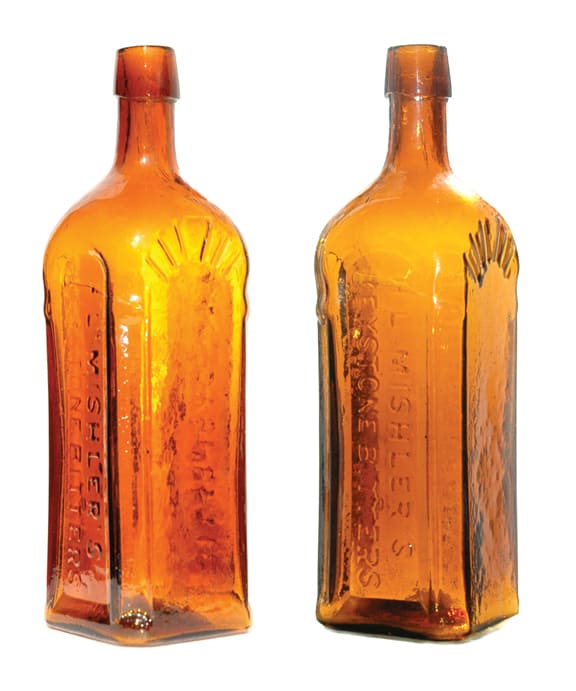
M 103: Mishler’s Keystone Bitters put out by Henry L. Mishler in Lancaster, Pennsylvania – Meyer Collection
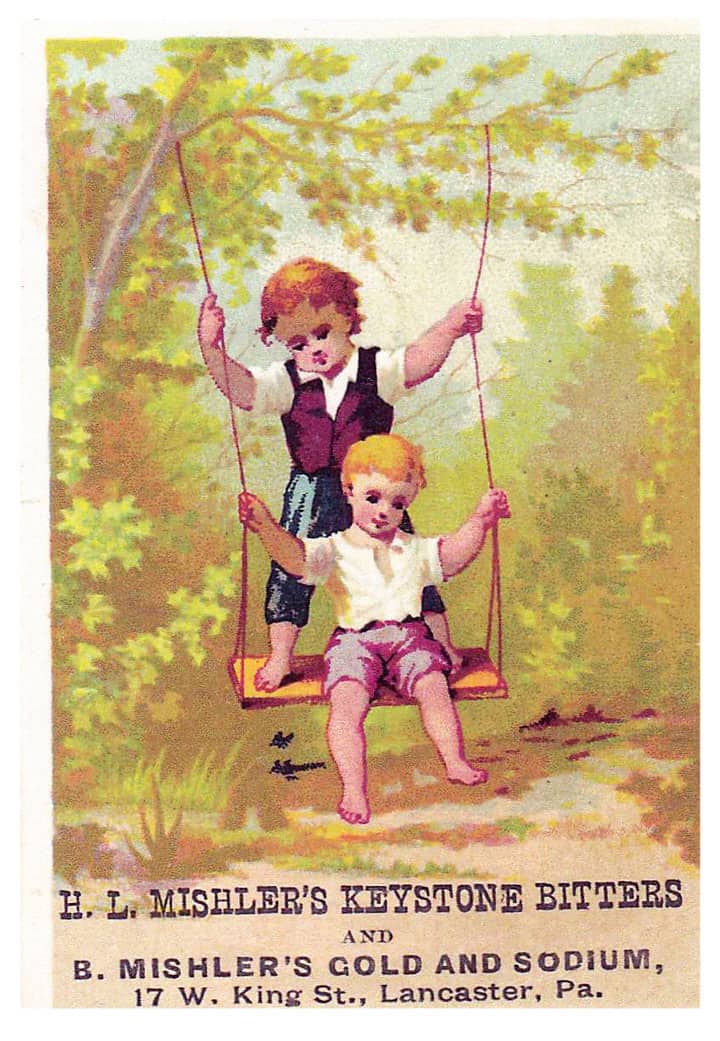
H. L. Mishler’s Keystone Bitters and B. Mishler’s Gold and Sodium trade card, 17 W. King Street, Lancaster, Pa.
Isaac Mishler
Son of John Mishler, brother of Benjamin Mishler. Benjamin and his brother Isaac were in the liquor business and had a distillery in East Cocalico Township, three miles northwest of Reamstown called Old Lion Brewery & Distillery. Issac went on to establish the Mishler Theater in Altoona, PA.
1827: Isaac Mishler born.
1863: MISHLER, ISAAC, wines and liquors, 127 N. Queen, h 129 N. Queen, Lancaster, Pennsylvania (see advertisement below) – Gopsill´s Directory of Lancaster, Harrisburg, Lebanon and York, 1863-64
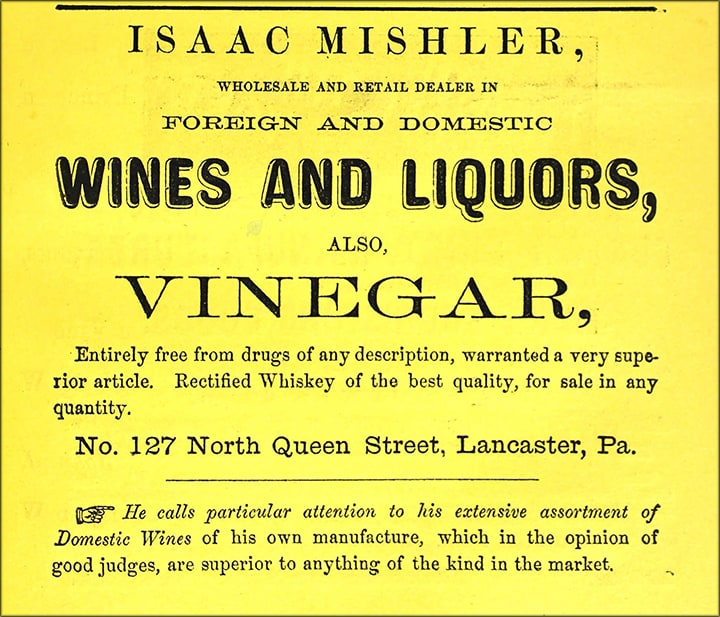
ISAAC MISHLER, wines and liquors, 127 N. Queen, h 129 N. Queen, Lancaster, Pennsylvania (see advertisement below) – Gopsill´s Directory of Lancaster, Harrisburg, Lebanon and York, 1863-64
1883: Isaac Mishler died
Jacob Mishler
Jacob Mishler was a distiller and farmer. His son was Evan Mishler. His brother was Benjamin Mishler.
1809: Jacob Mishler born.
1846: Jacob Mishler takes charge of the Packerack hotel in Reading, Pennsylvania.
1848: Jacob Mishler takes control of the Golden Horse hotel and purchases it in 1855.
1860: Jacob Mishler tears down the Golden Horse hotel and builds the Mishler House.
1865: Jacob Misher dies in Reading, Penn.
John Mishler
Father of Benjamin Mishler, wife Maria Reinhold
1788: Birth January 20, 1788 in Cocalico Township, Lancaster, Pennsylvania, Parents Joseph Mishler (1757-1814) and Margaret Bear (1766-1853)
1869: Death October 11, 1869 in Lancaster, Lancaster, Pennsylvania
John Mishler
Son of John Mishler
1812: John Mishler born 1812
1893: John Mishler died 1893
Samuel B. Hartman
MISHLER’S HERB BITTER’S | DR. S. B. HARTMAN & CO., Trade Mark No. 218, dated April 1871. M 99: There are at least four (4) variants.
Dr. S. B. Hartman & Co. were successors to Benjamin Mishler of Lancaster, Pennsylvania. They produced Red Label, Green Label and Herb Bitters. The firm included Dr. Samuel B. Hartman, Junius Kaufman and Henry Lehman, manager. In 1867, S. B. Hartman purchased the firm from Benjamin Mishler who then left and joined his son Henry in producing H. L. Mishler’s Keystone Bitters.
1867: Dr. S. B. Hartman purchased the firm from Benjamin Mishler who then left and joined his son Henry in producing H. L. Mishler’s Keystone Bitters.
1883: Dr. S. B. Hartman sold his interest to the Mishler Herb Bitters Company.
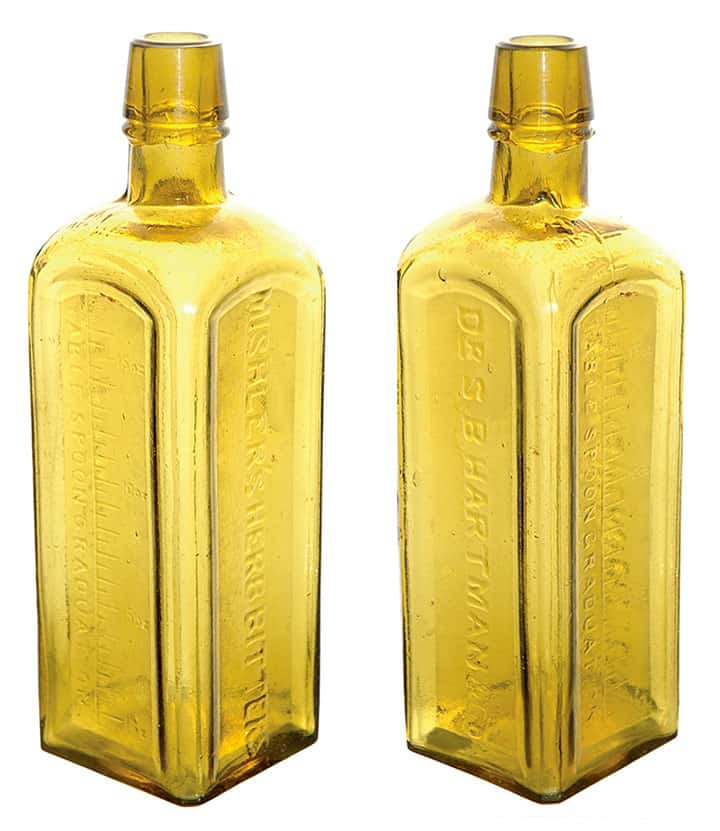
M99: Mishler’s Herb Bitters, Dr. S. B. Hartman & Co (motif ruled marker) in yellow – Meyer Collection
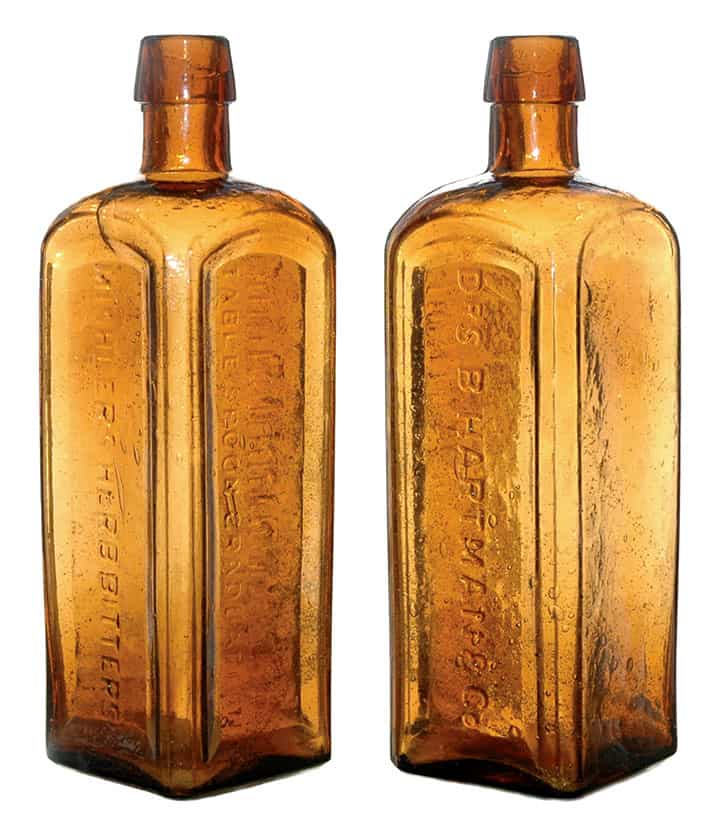
M99: Mishler’s Herb Bitters, Dr. S. B. Hartman & Co (motif ruled marker) in apricot – Meyer Collection
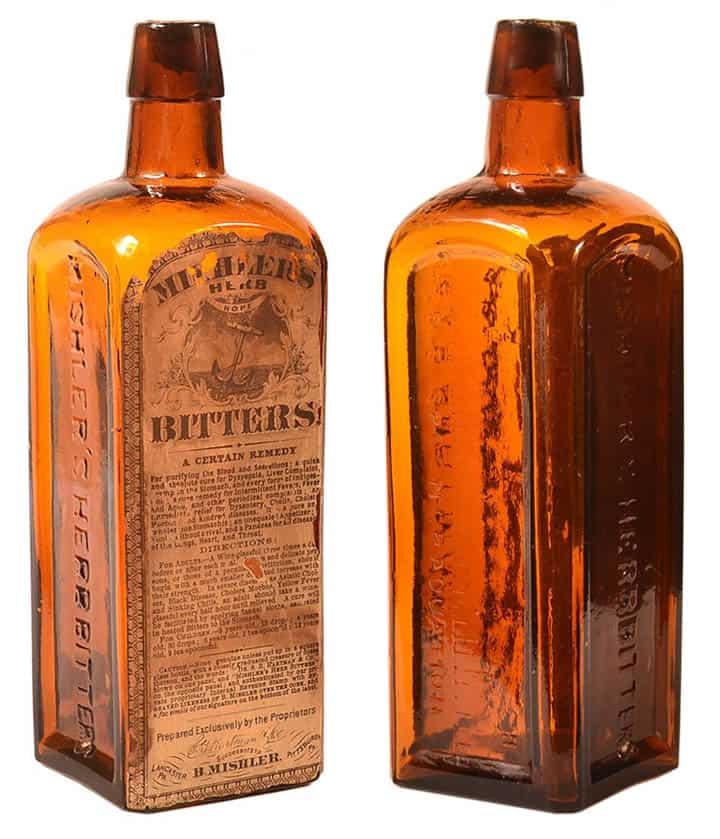
M 99.1: Labeled Mishler’s Herb Biters, Dr. S. B. Hartman & Co, (table spoon graduation), The O in CO is raised. The S in BITTERS extends onto bevel. NO. 1 on base. Nolt Collection – Conestoga Auction Company
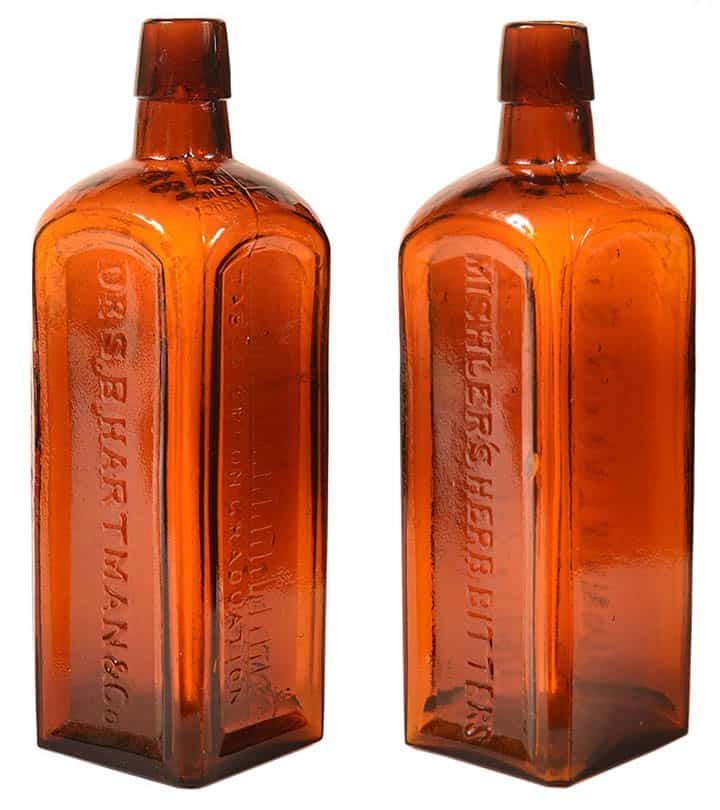
M 99.2: Mishler’s Herb Biters, Dr. S. B. Hartman & Co, (table spoon graduation), The O in CO is raised. The S in BITTERS extends onto bevel. NO. 2 on base. Nolt Collection – Conestoga Auction Company
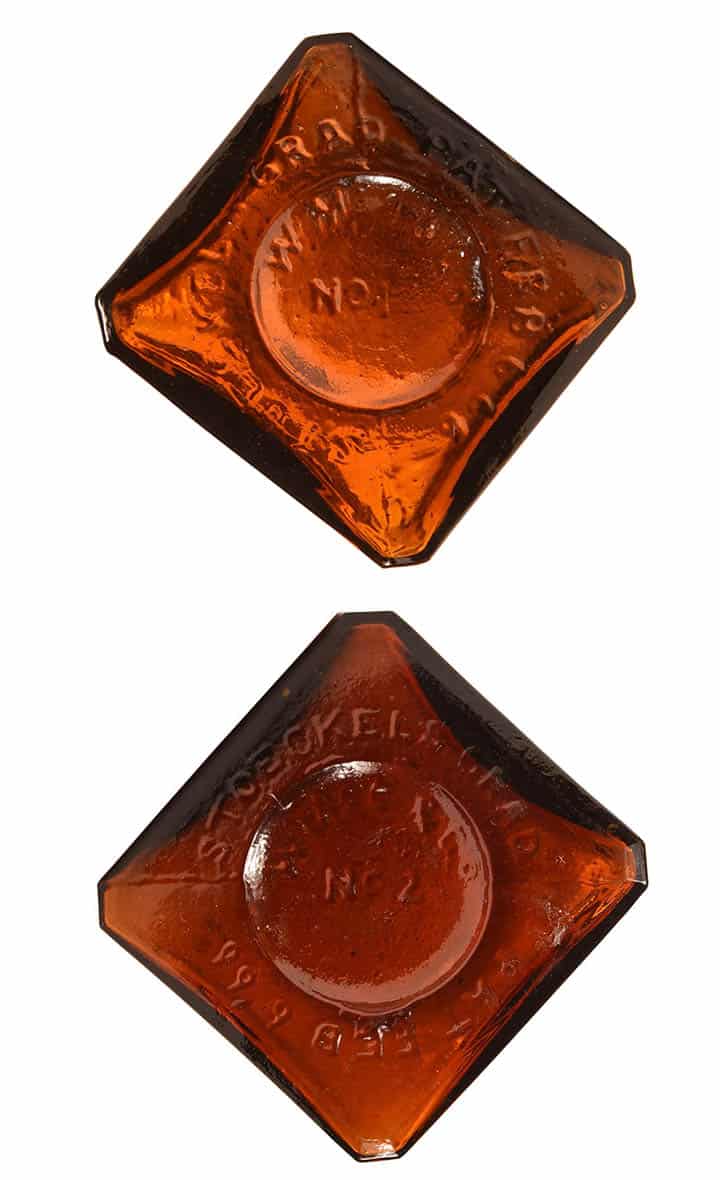
M 99.1: Mishler’s Herb Biters, Dr. S. B. Hartman & Co, (table spoon graduation), NO. 1 on base. (see above) Nolt Collection – Conestoga Auction Company. M 99.2: Mishler’s Herb Biters, Dr. S. B. Hartman & Co, (table spoon graduation), The O in CO is raised. The S in BITTERS extends onto bevel. NO. 2 on base. (see above) Nolt Collection – Conestoga Auction Company
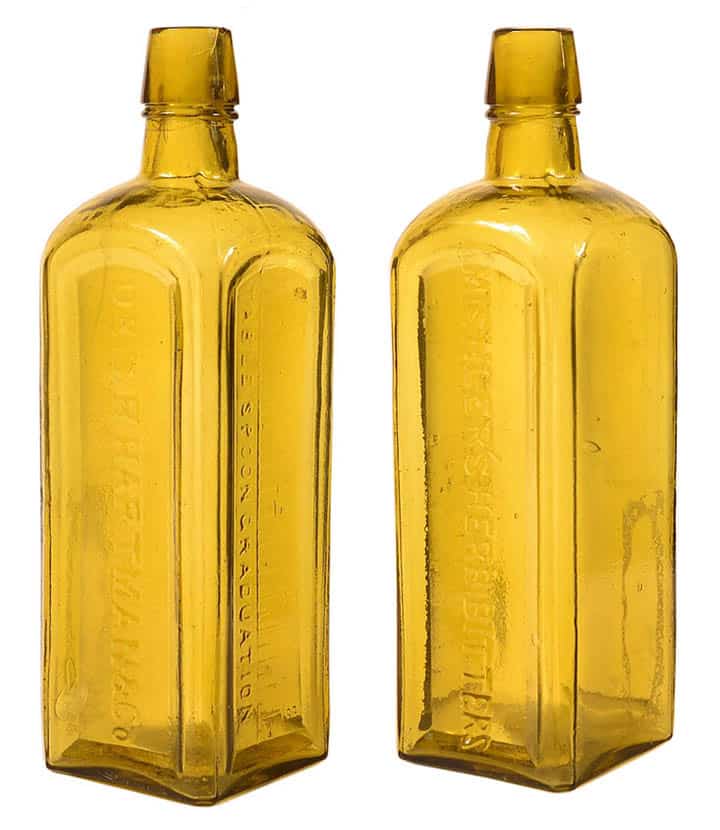
M 99.2: Mishler’s Herb Biters in yellow, Dr. S. B. Hartman & Co, (table spoon graduation), The O in CO is raised. The S in BITTERS extends onto bevel. NO. 2 on base. Nolt Collection – Conestoga Auction Company

Mishler’s Herb Bitters cover, Dr. S. B. Hartman & Co., Proprietors, Lancaster & Pittsburg, PA. – Ben Swanson Collection

Mishler’s Herb Bitters cover, Dr. S. B. Hartman & Co., Sole Proprietors, Lancaster & Pittsburg, PA. – Ben Swanson Collection

Full page advertisement for Mishler’s Herb Bitters, Dr. S.B. Hartman & Co., Lancaster, Penna. – 1869 Directory of Lancaster County
Mishler’s Herb Bitters Company
1883: Dr. S. B. Hartman sold his interest to the Mishler Herb Bitters Company. They were located in Lancaster, Philadelphia and Pittsburgh, Pennsylvania.
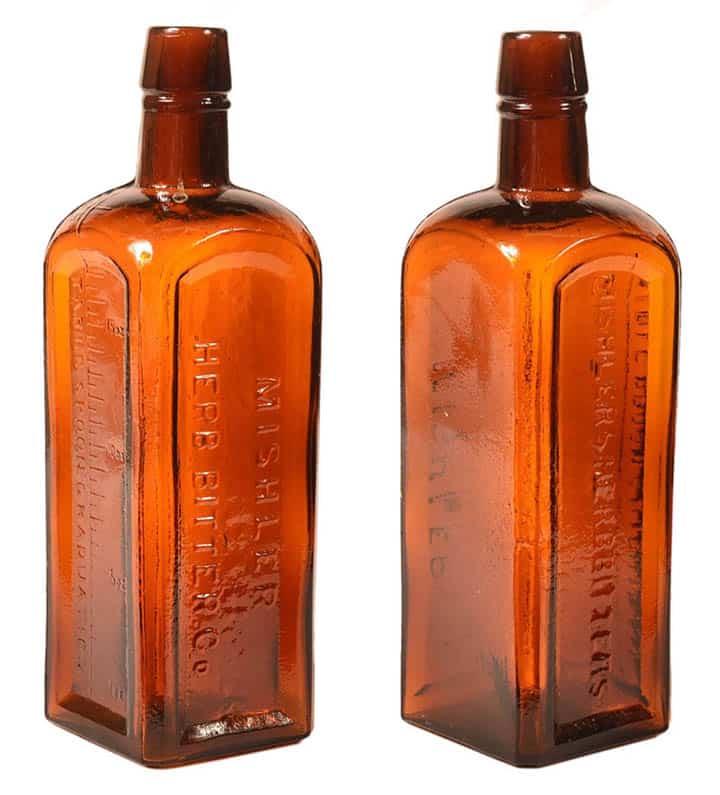
M 100: Mishler’s Herb Bitters, Mishler Herb Bitters Co. (Dr. S. B. Hartman has been peened out between Mishler and Herb Bitters Co.) Nolt Collection – Conestoga Auction Company
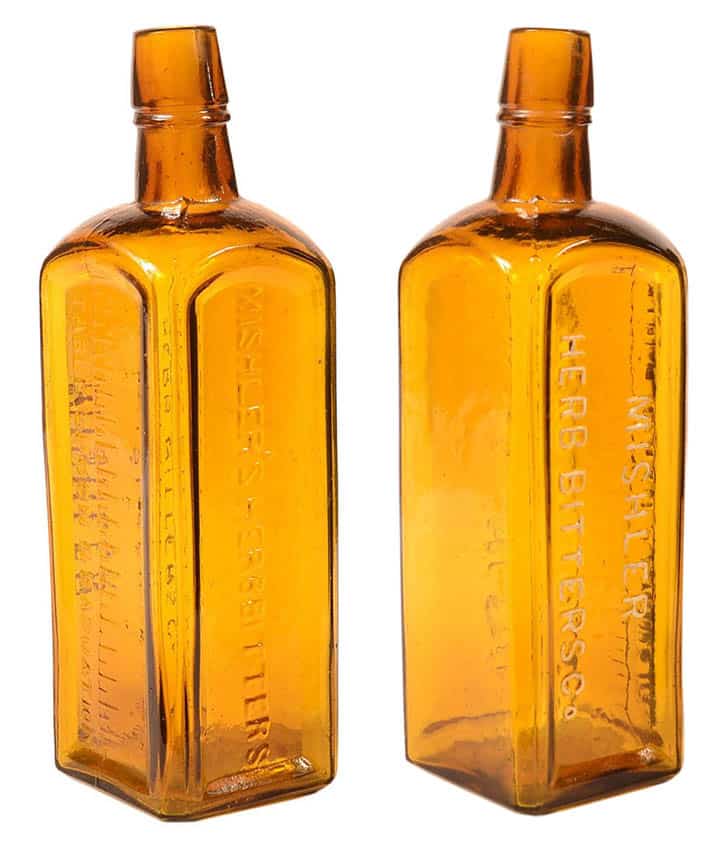
M 100: Mishler’s Herb Bitters, Mishler Herb Bitters Co. (Dr. S. B. Hartman has been peened out between Mishler and Herb Bitters Co.) in a honey amber with crooked neck. Nolt Collection – Conestoga Auction Company

